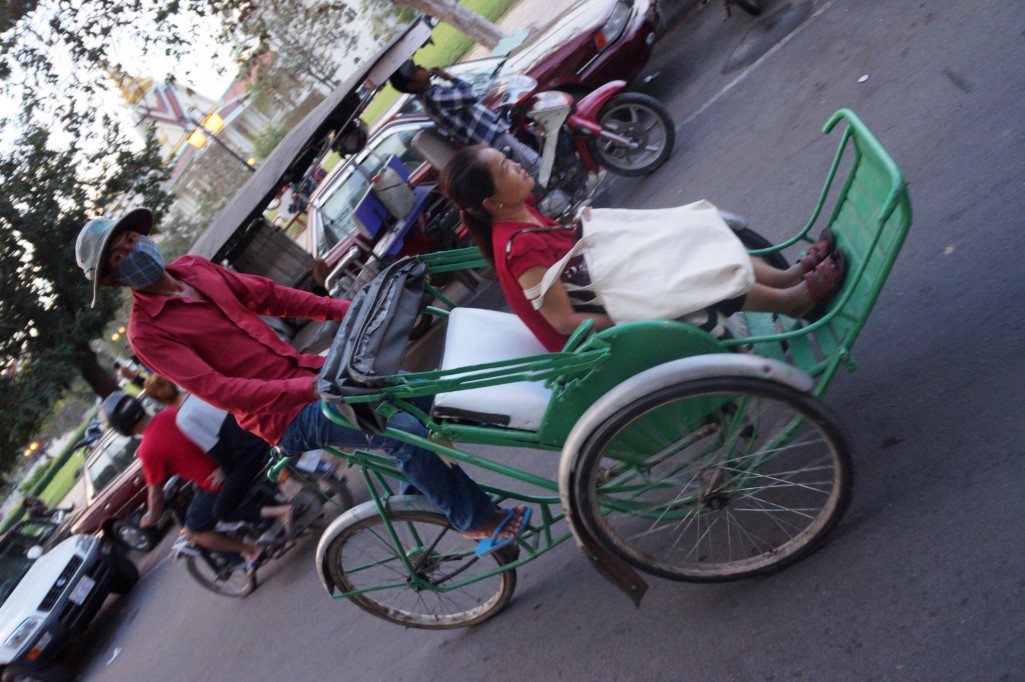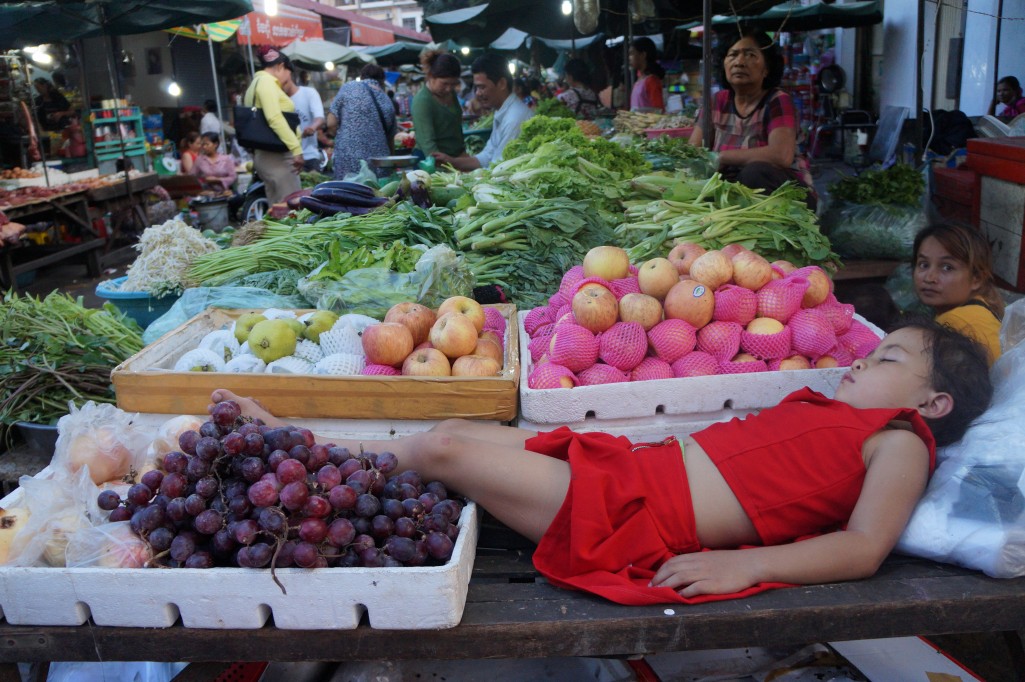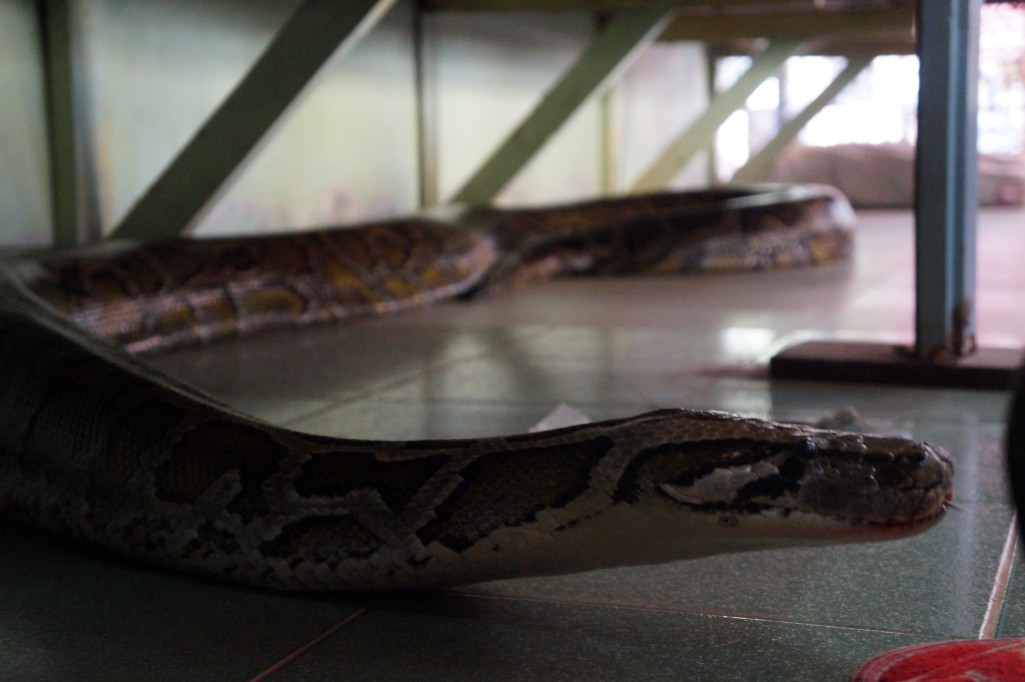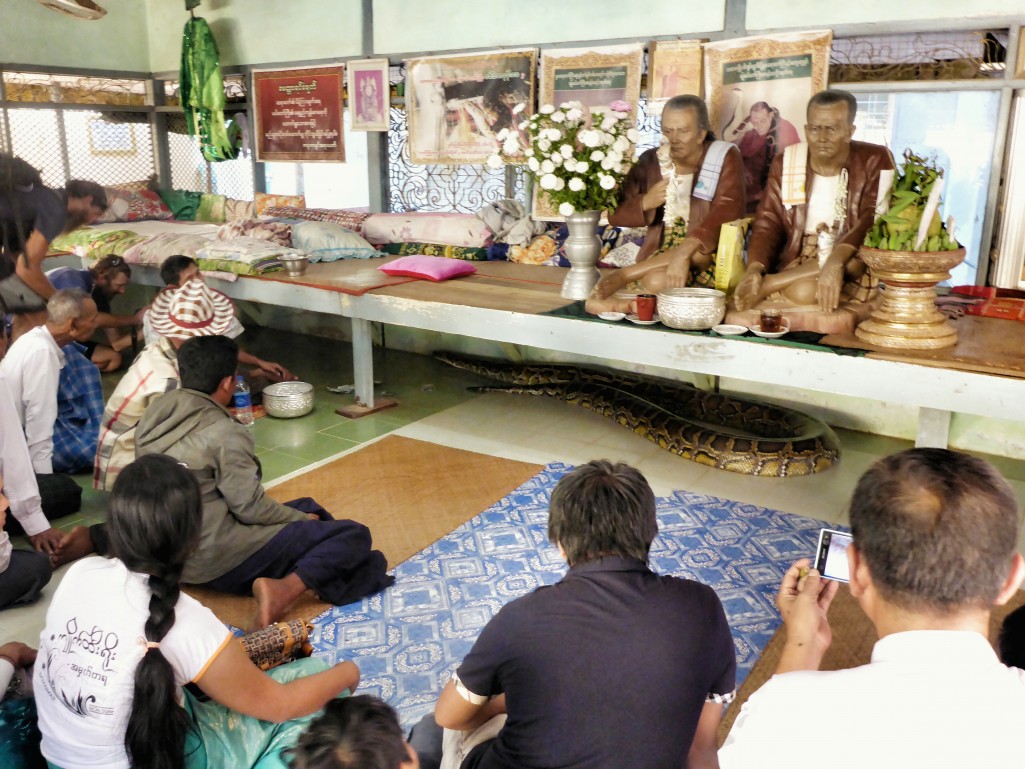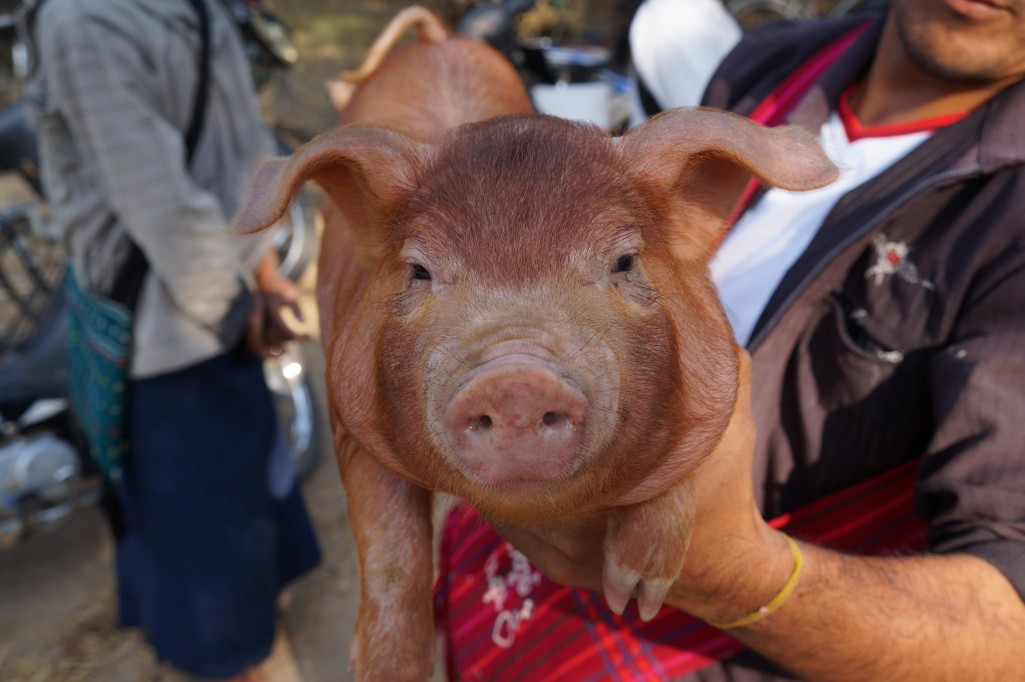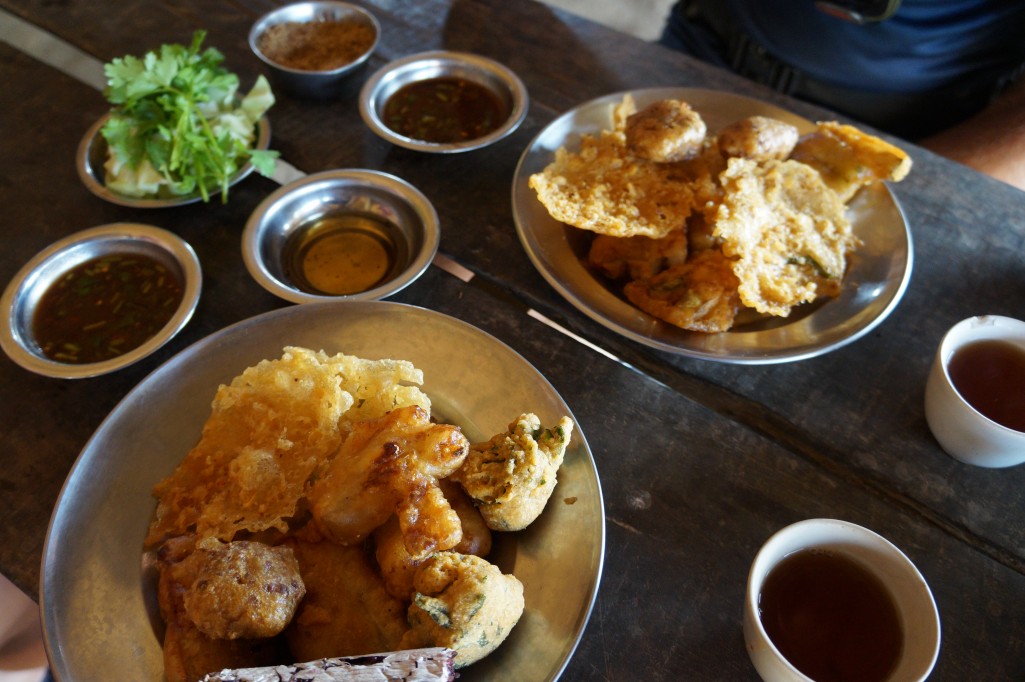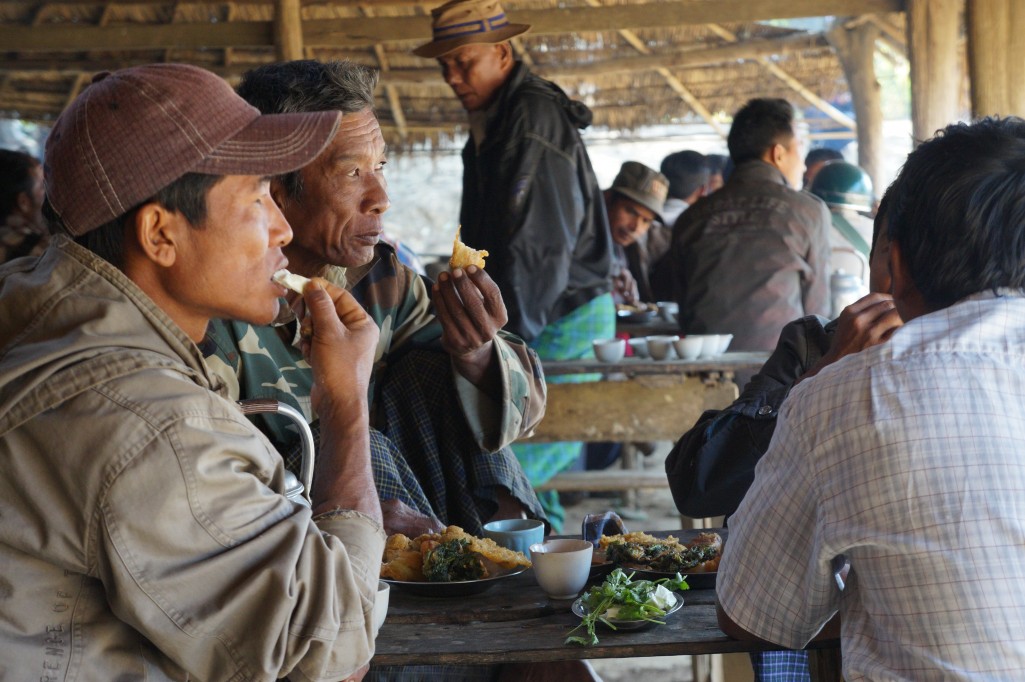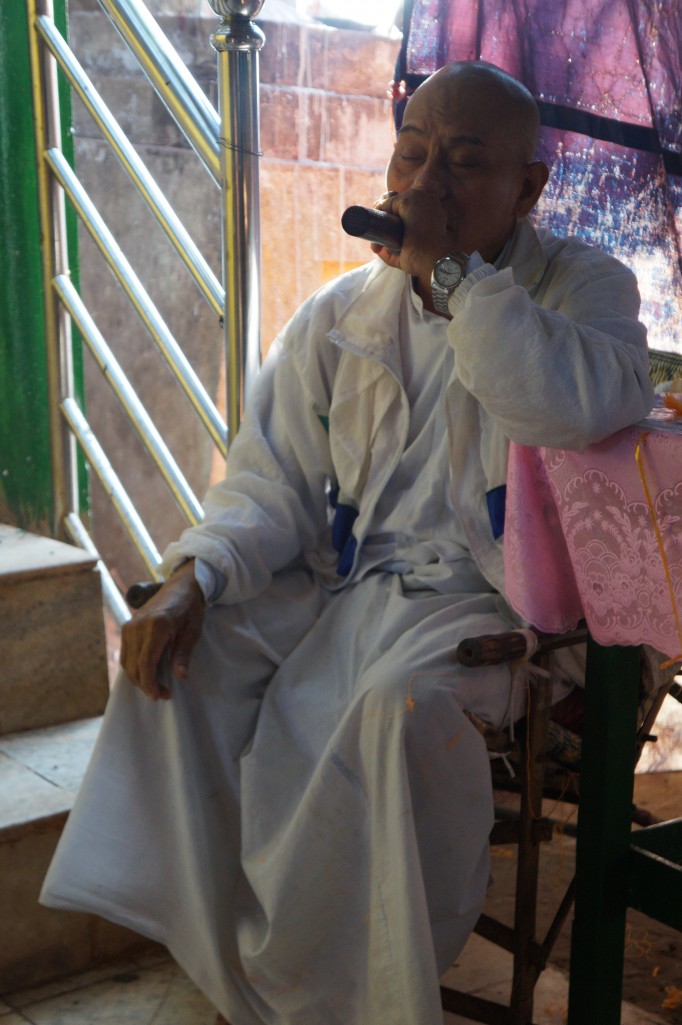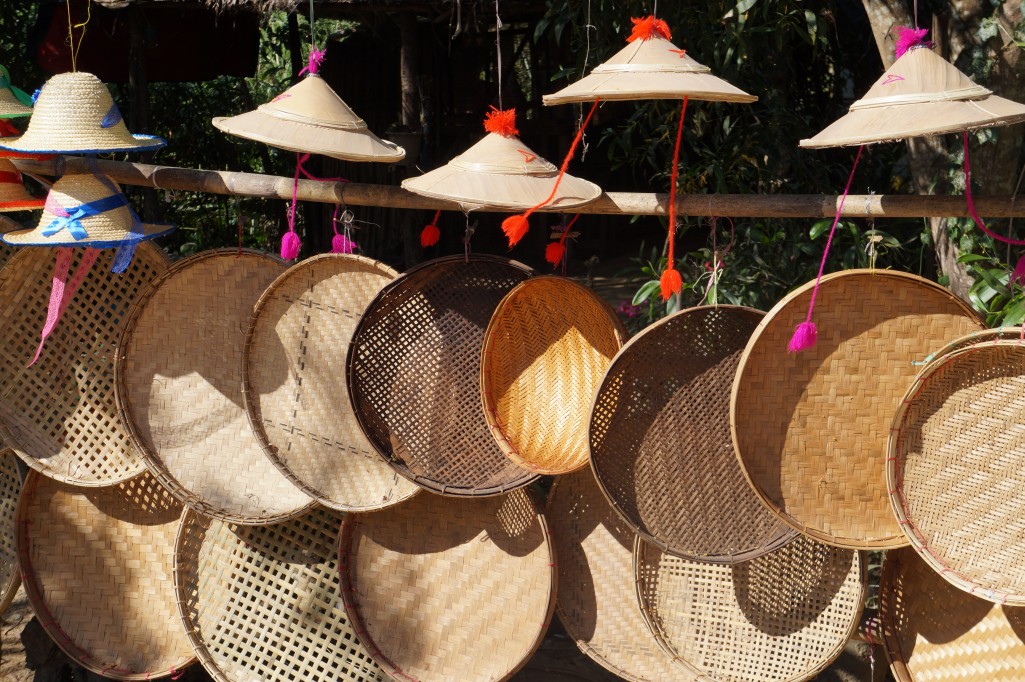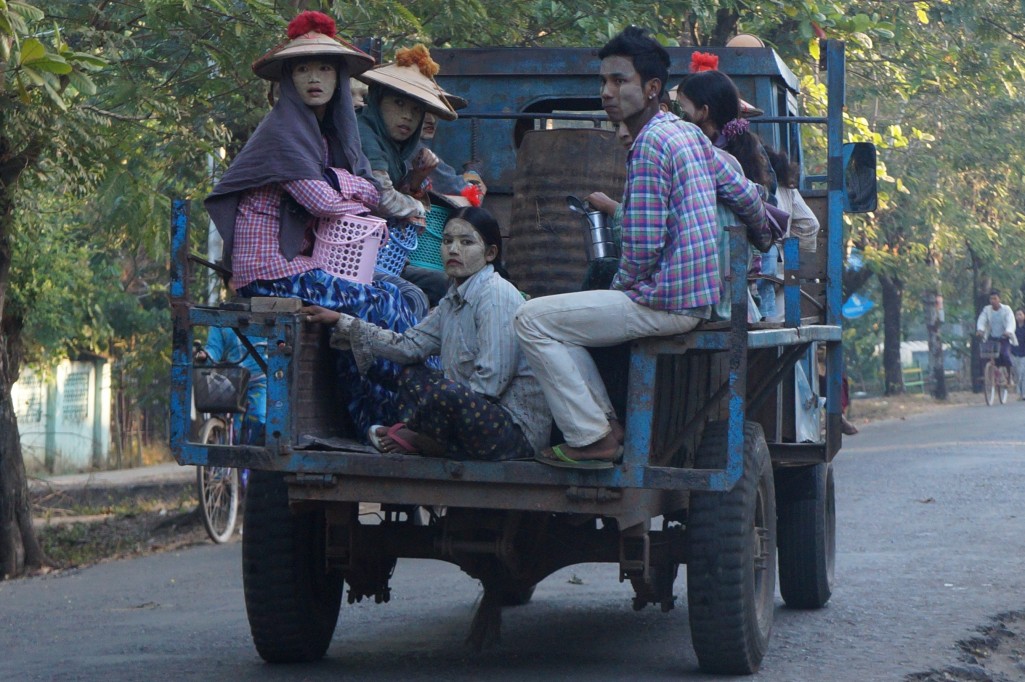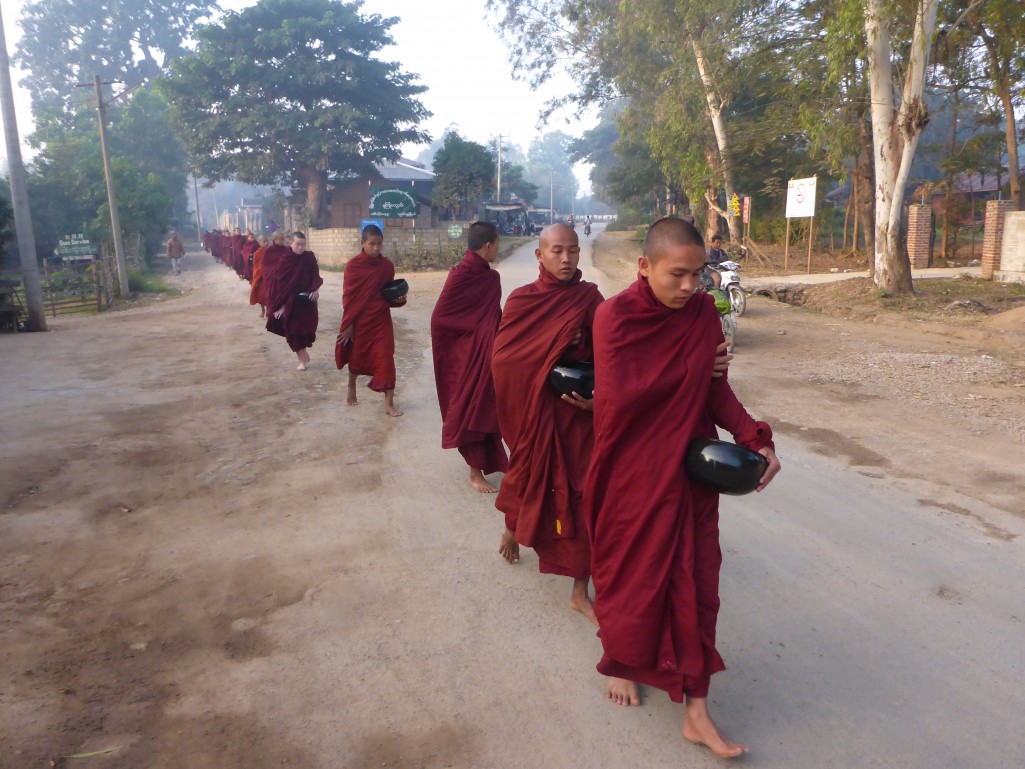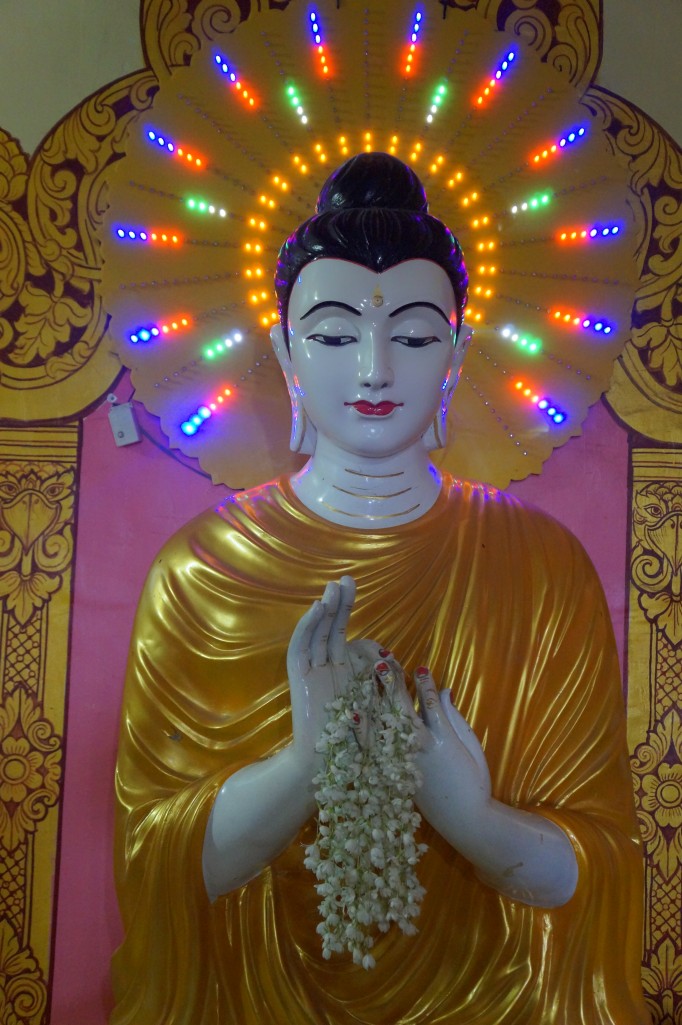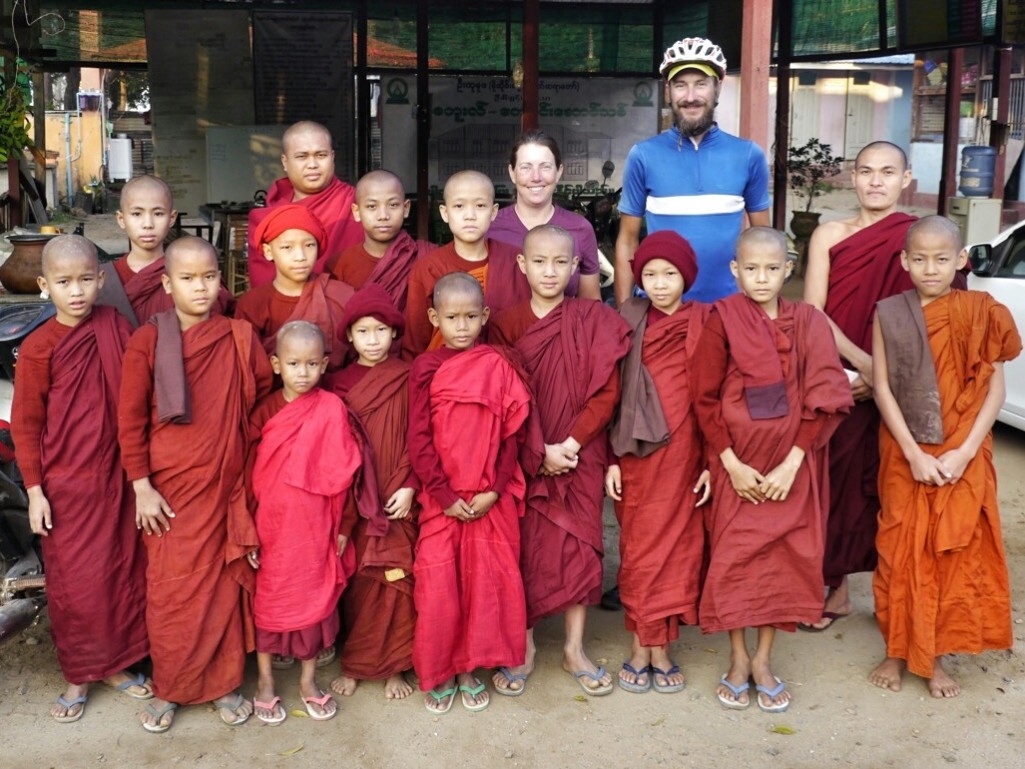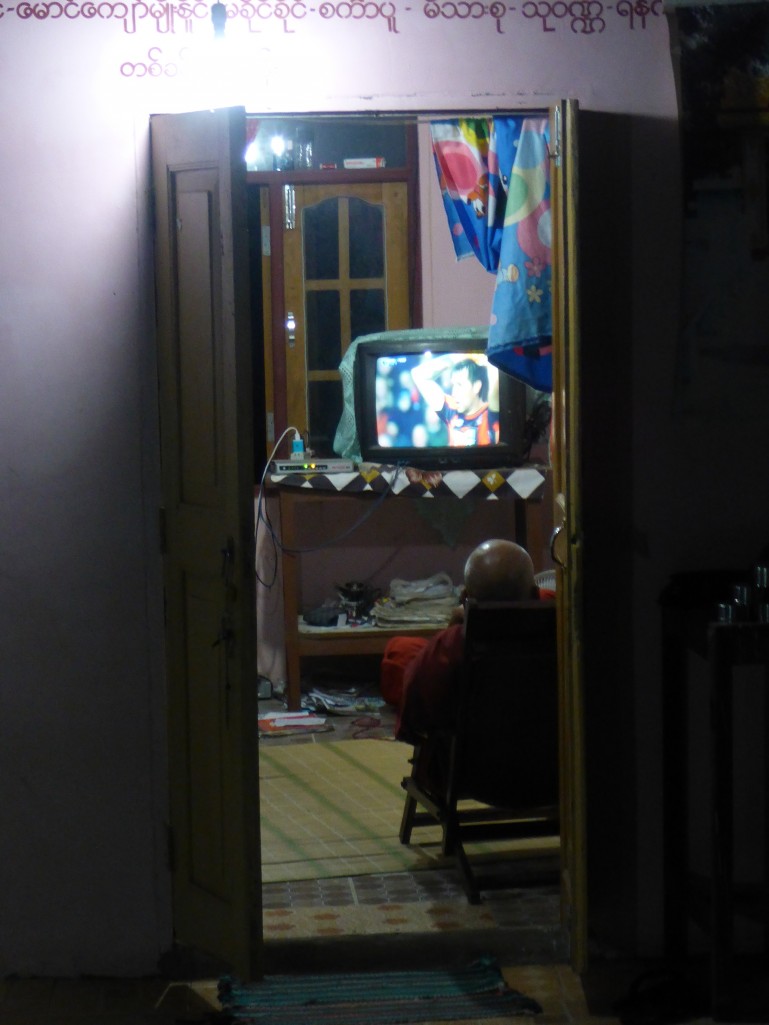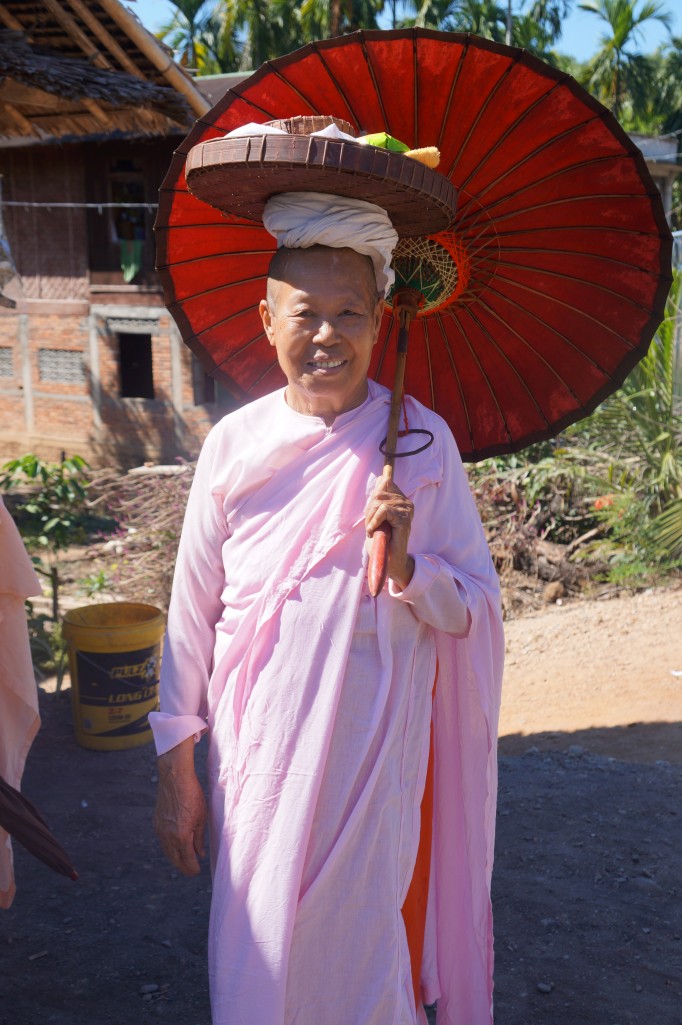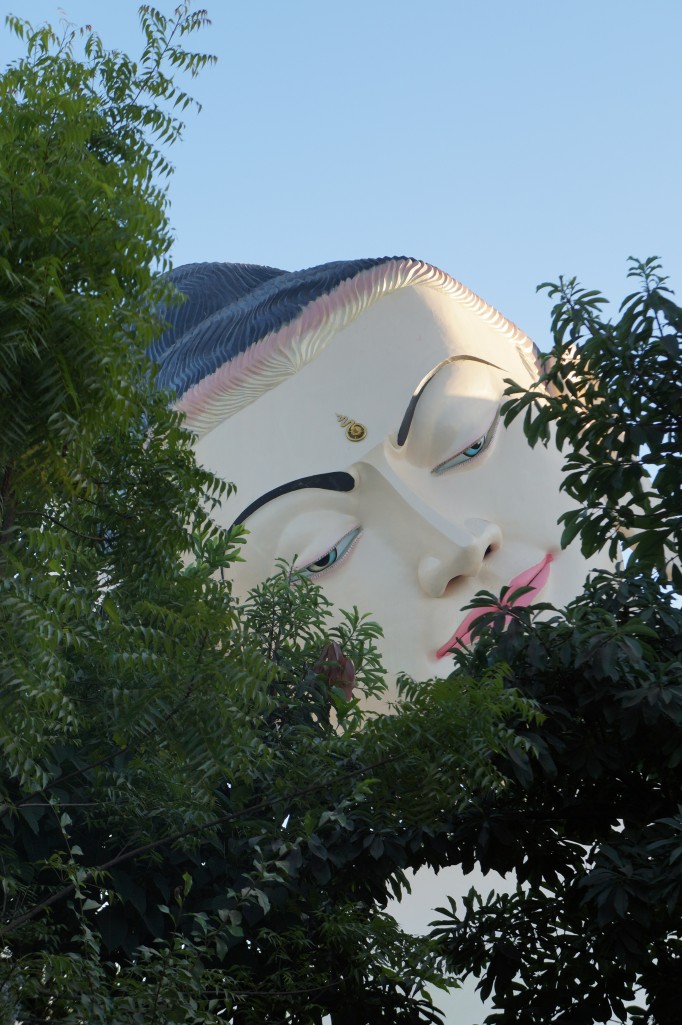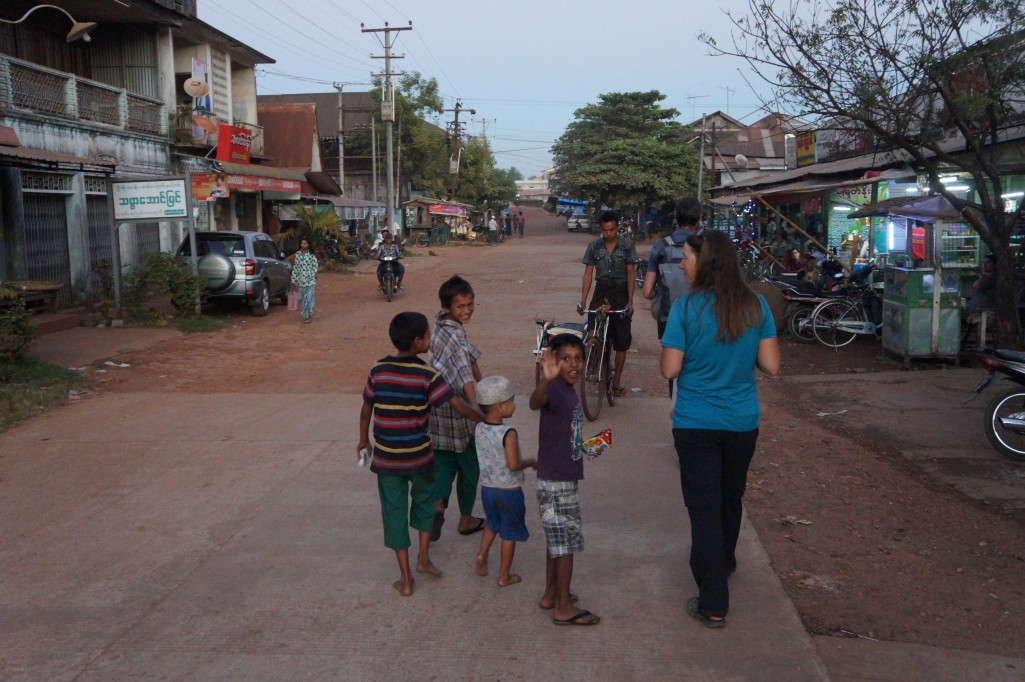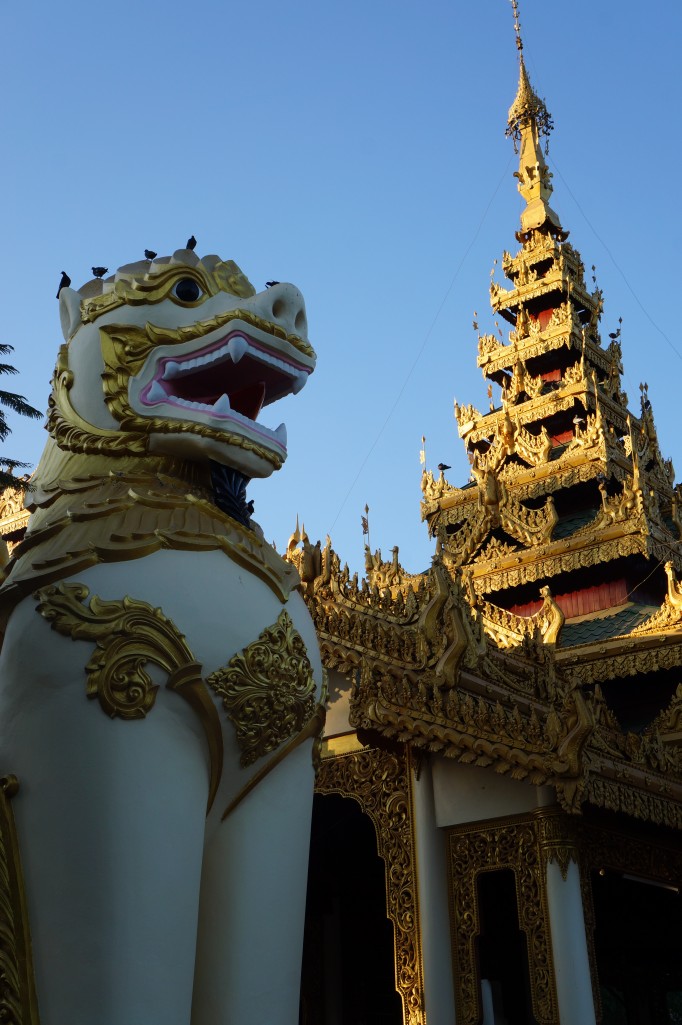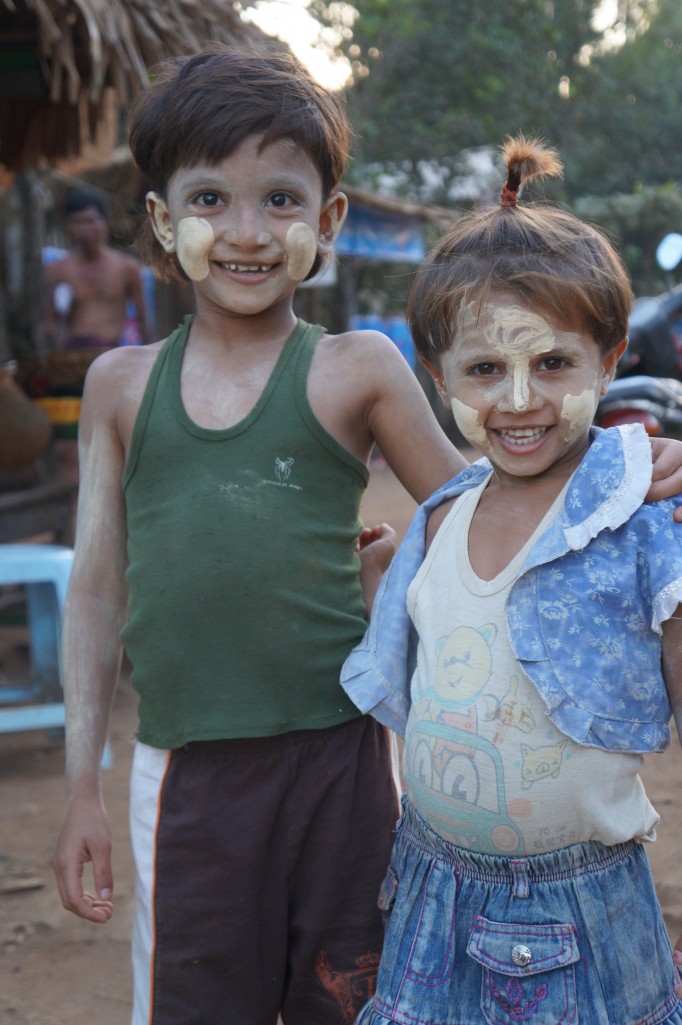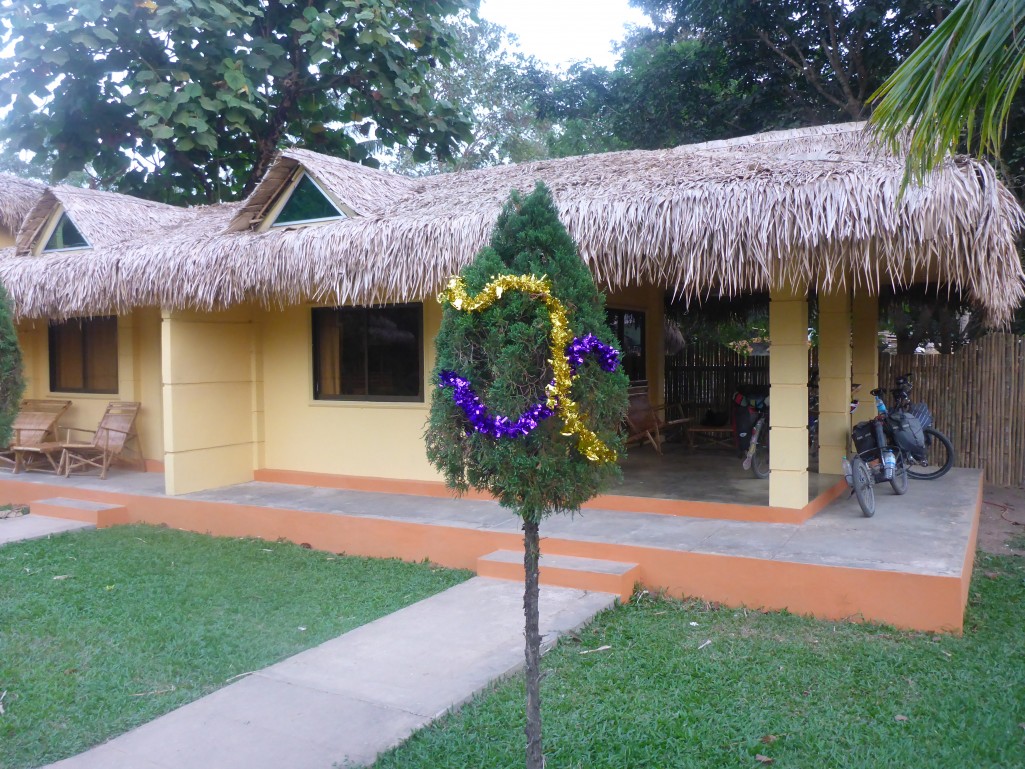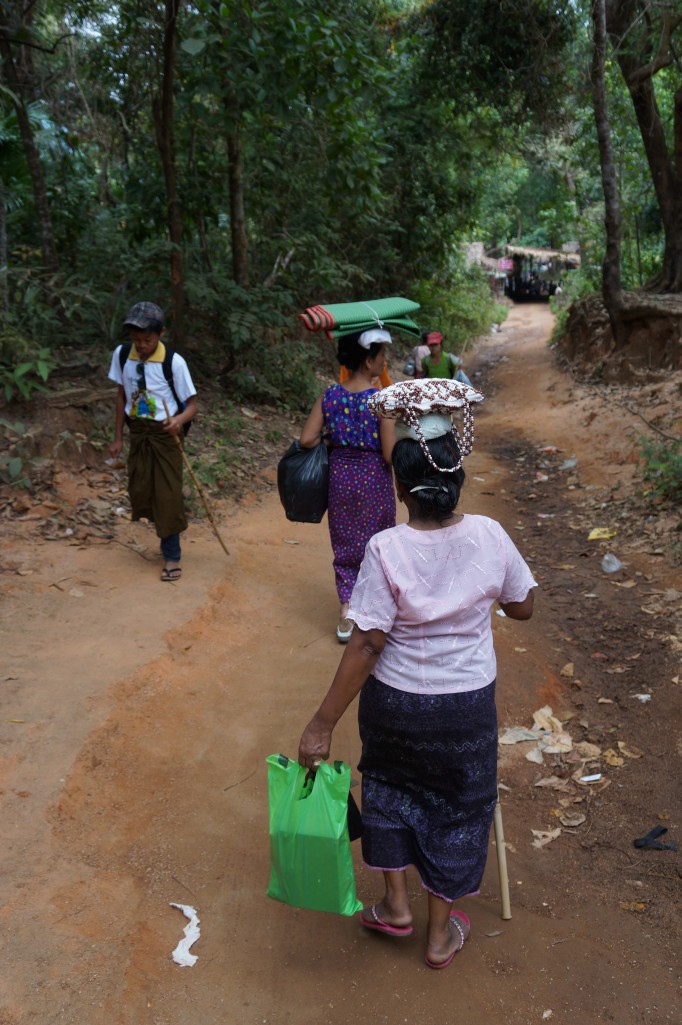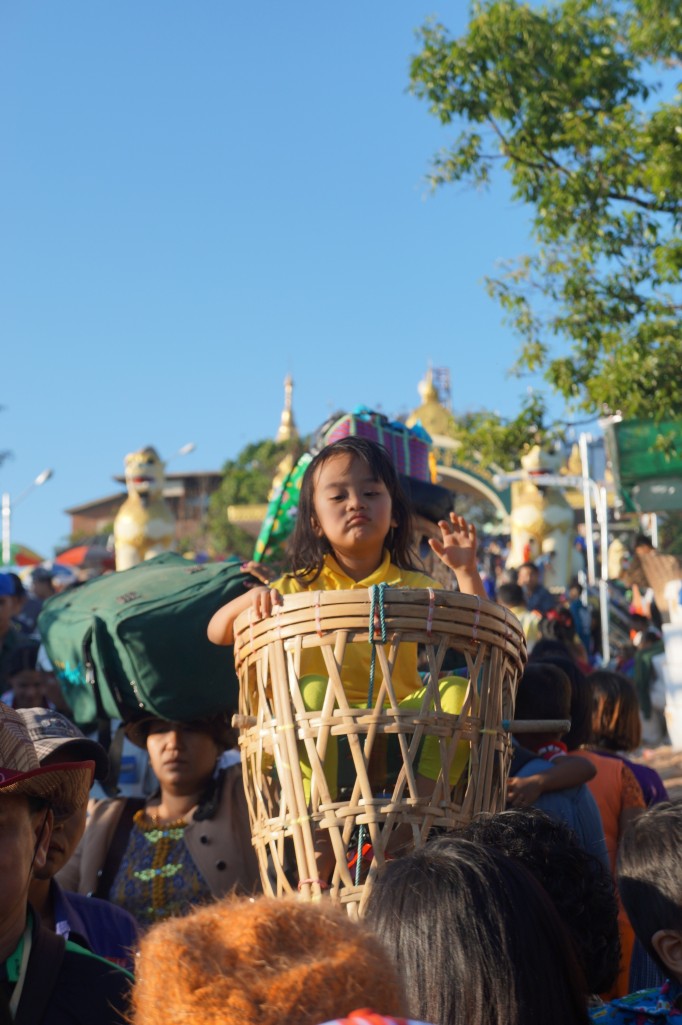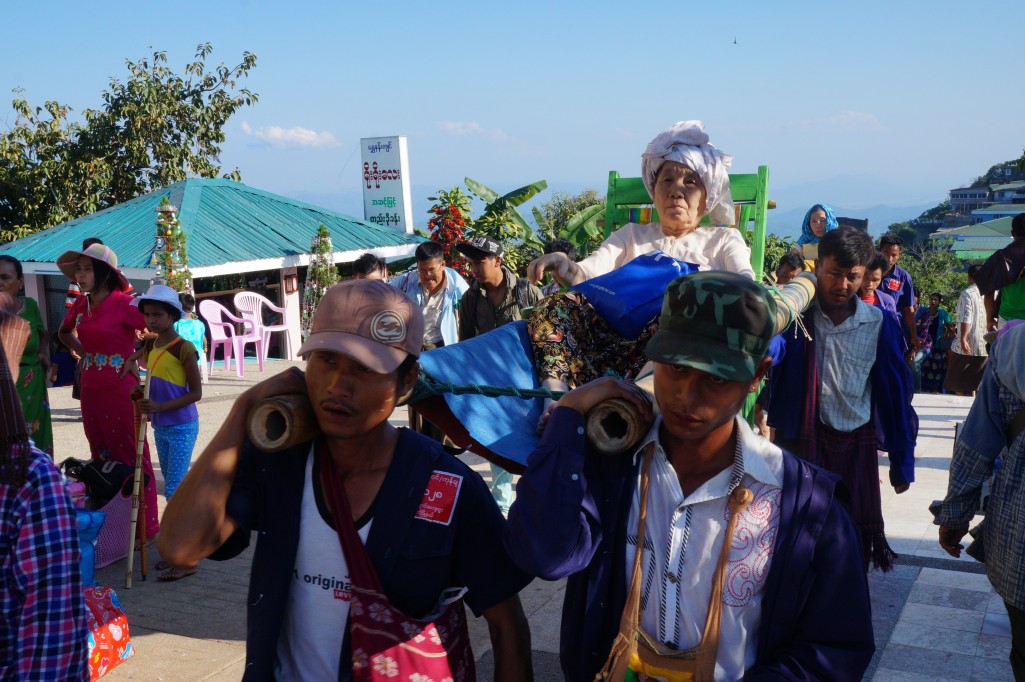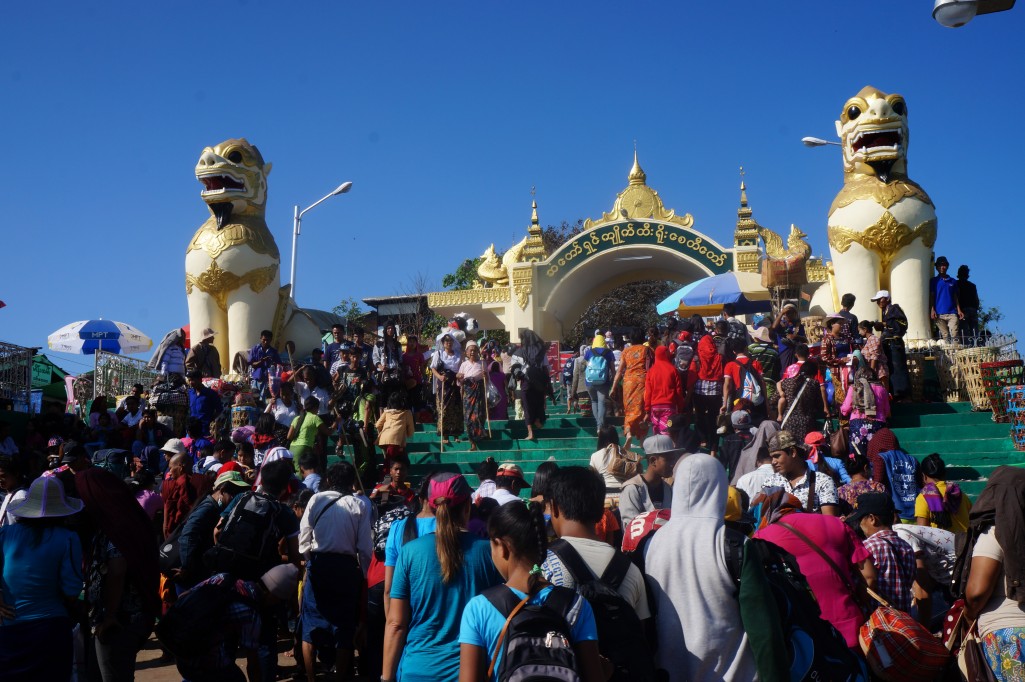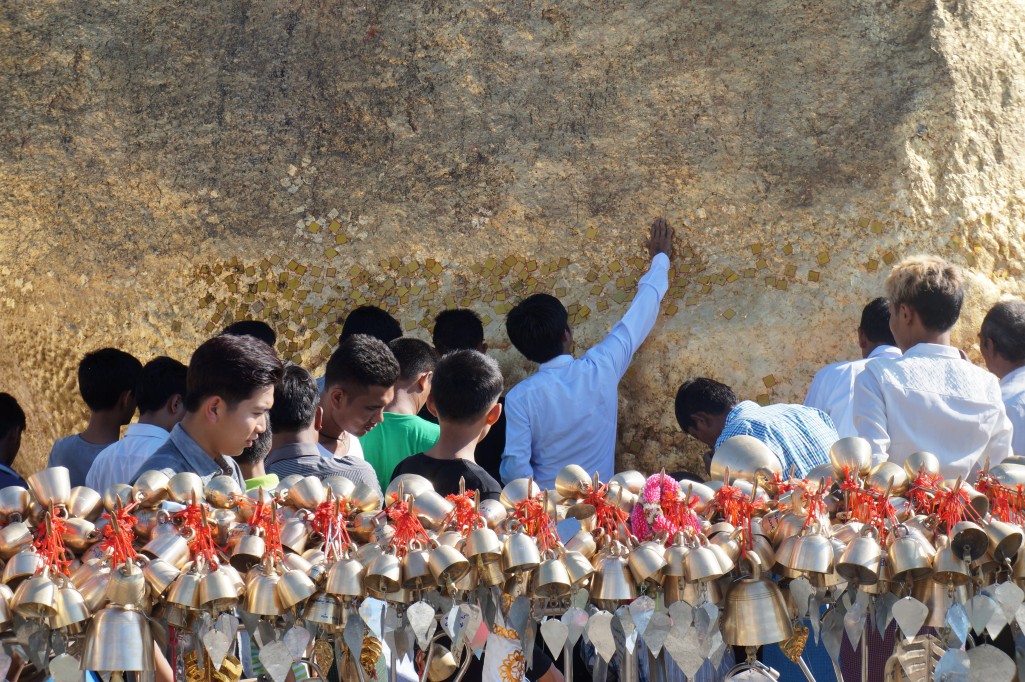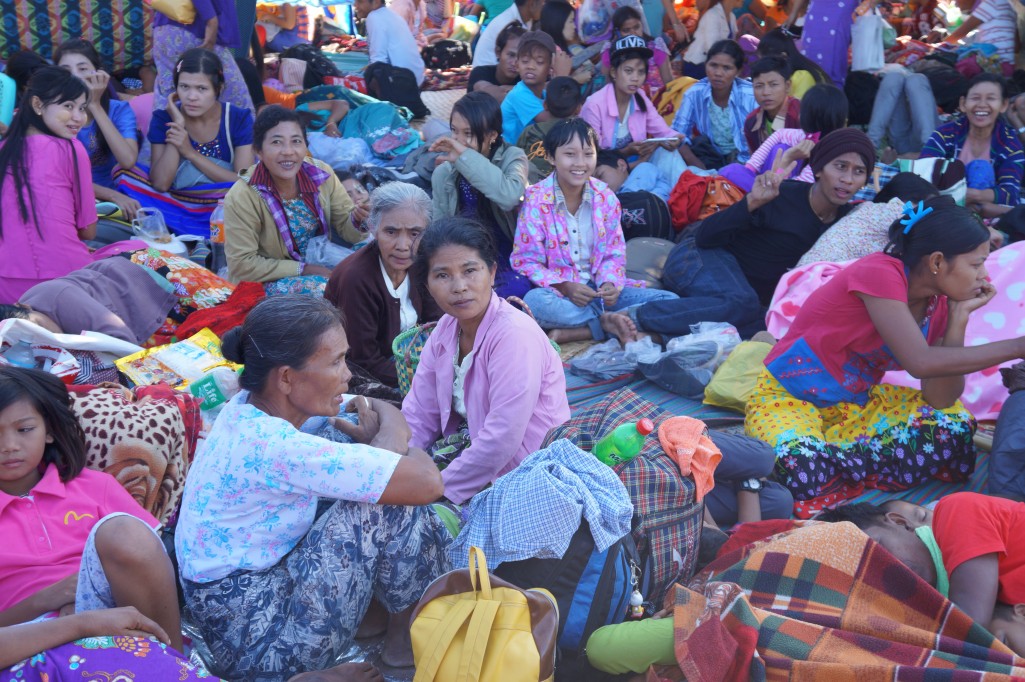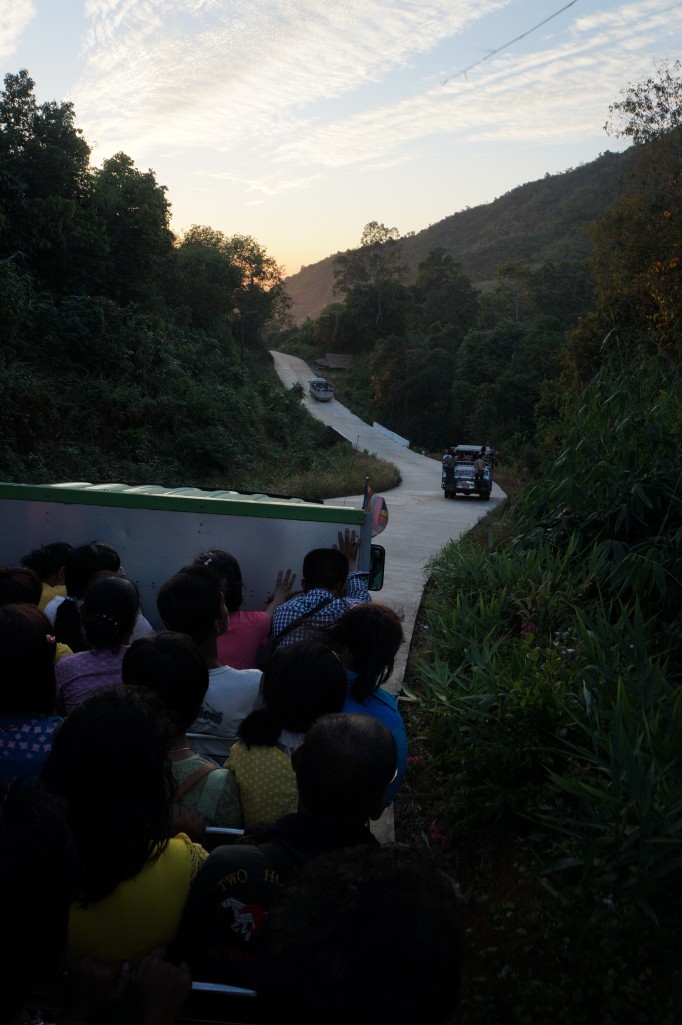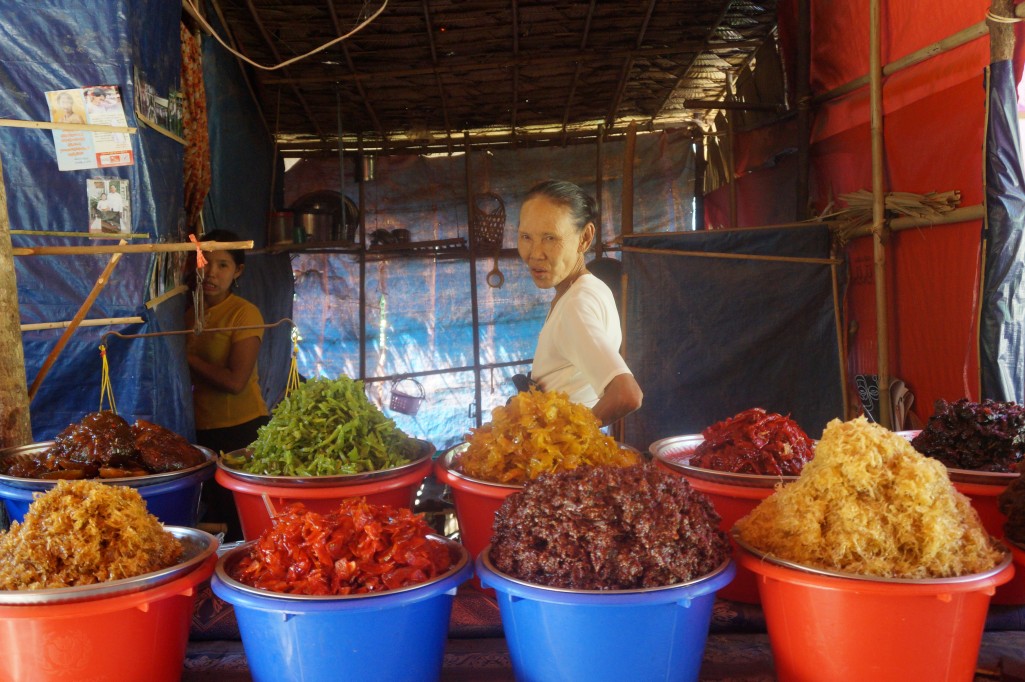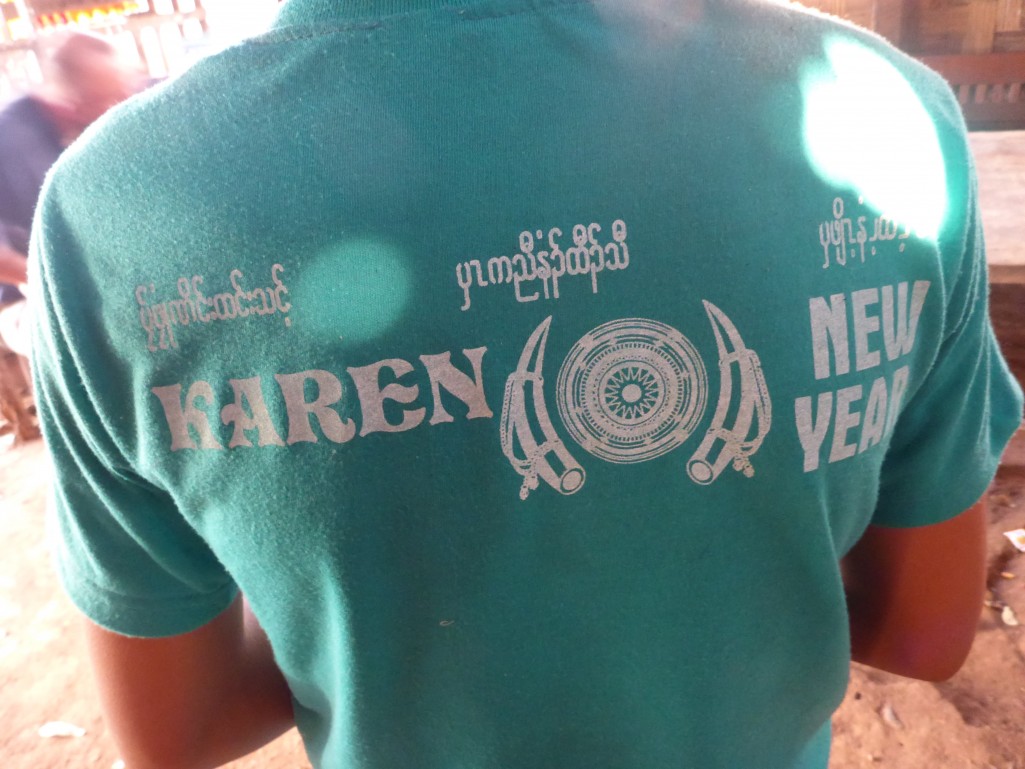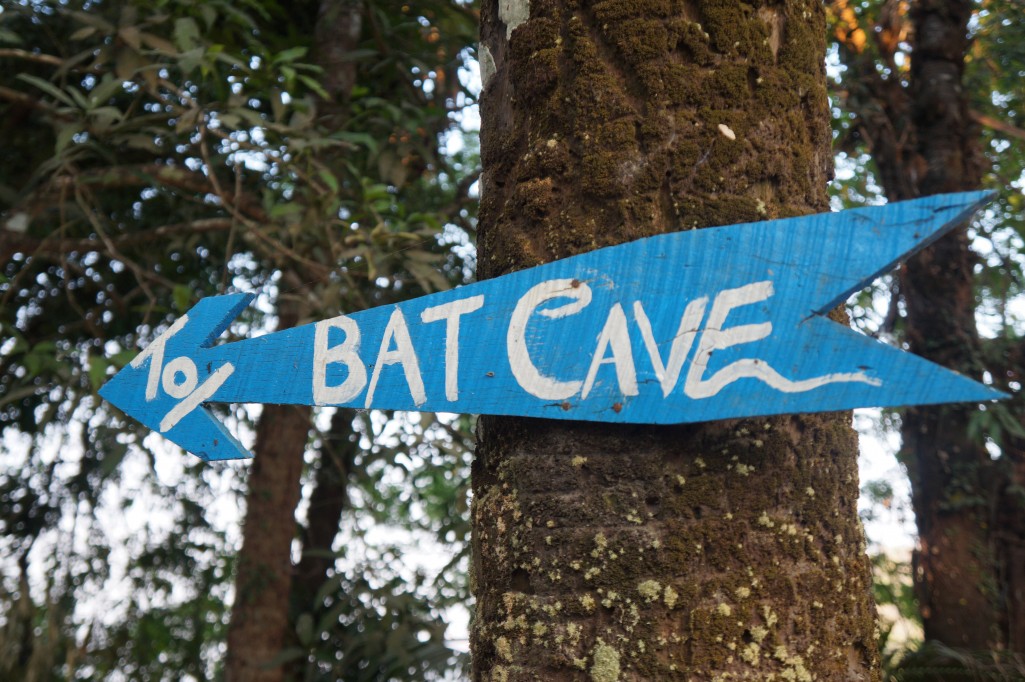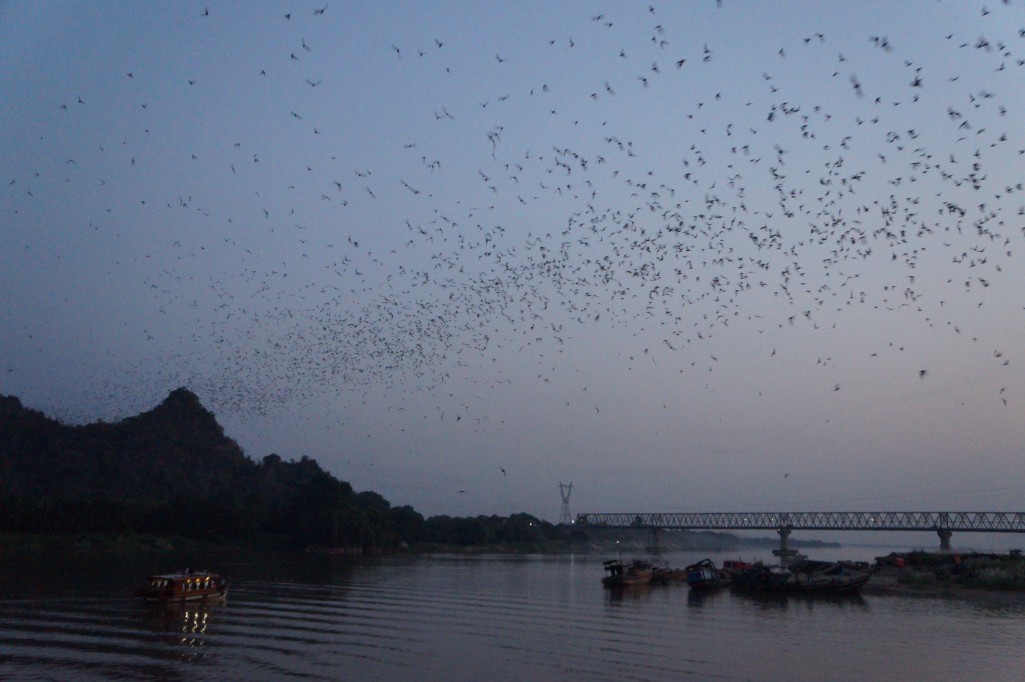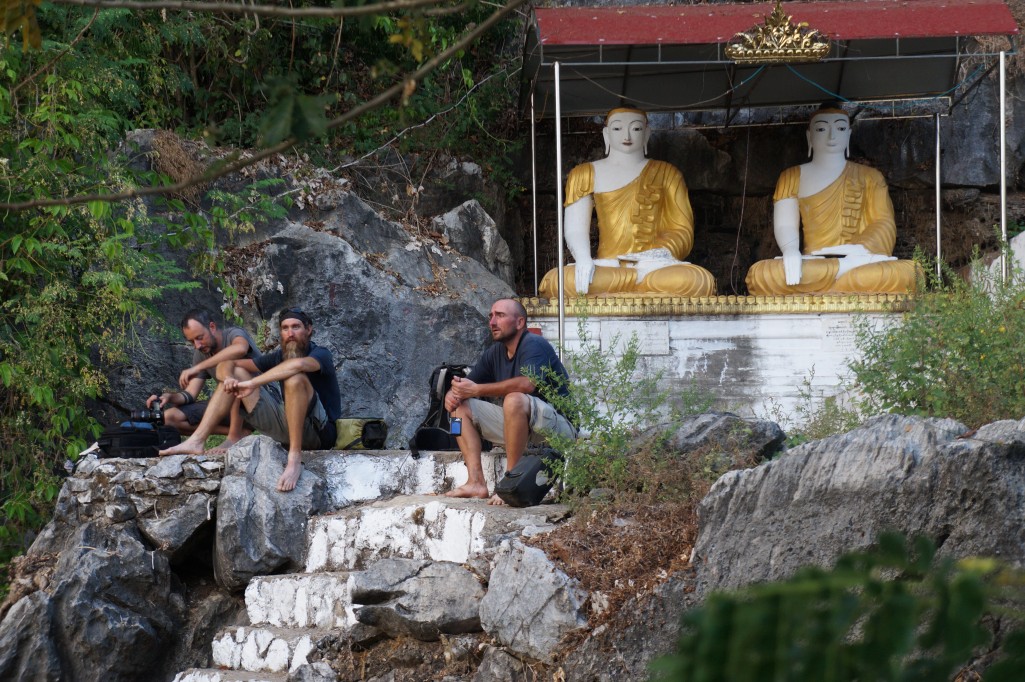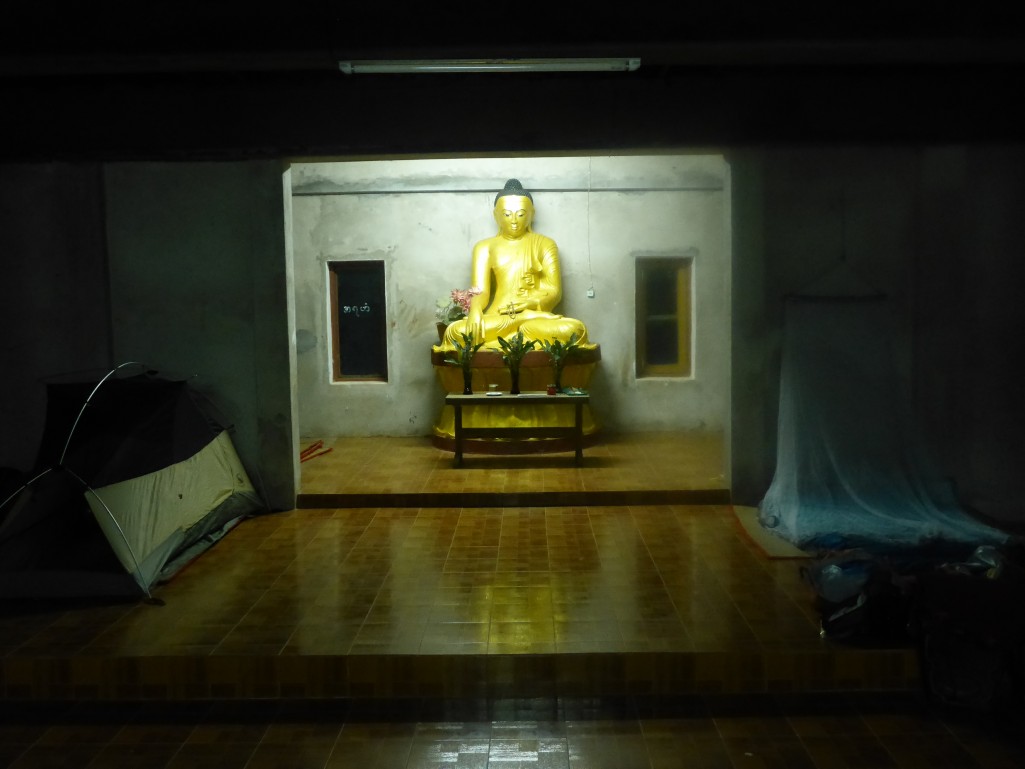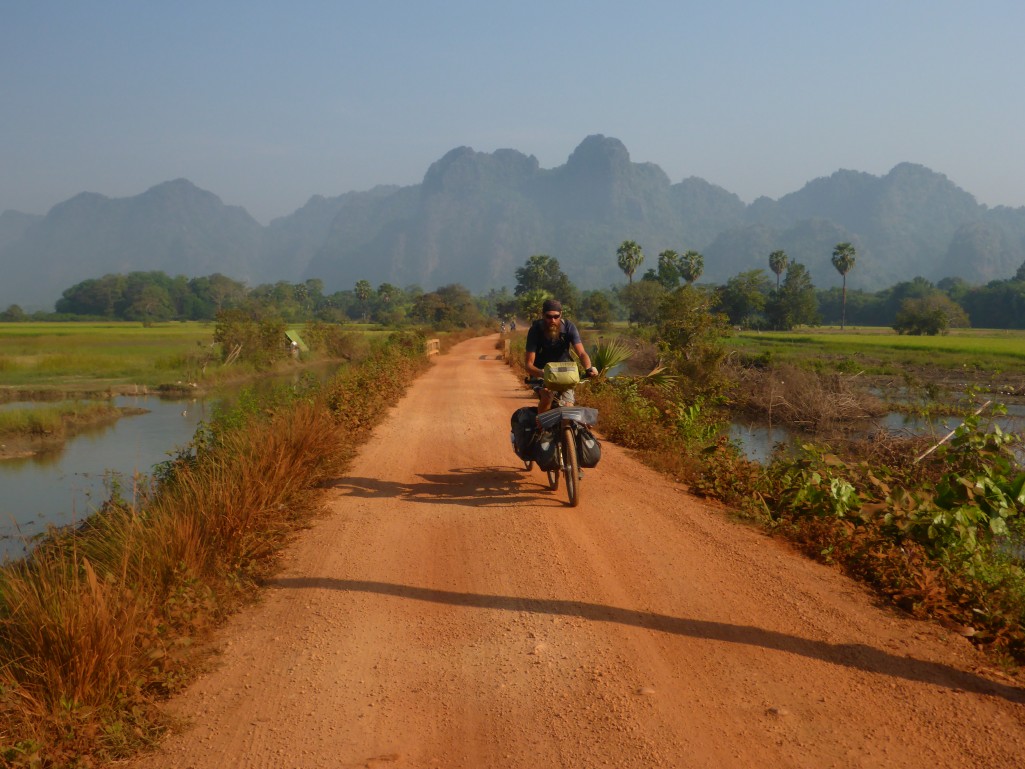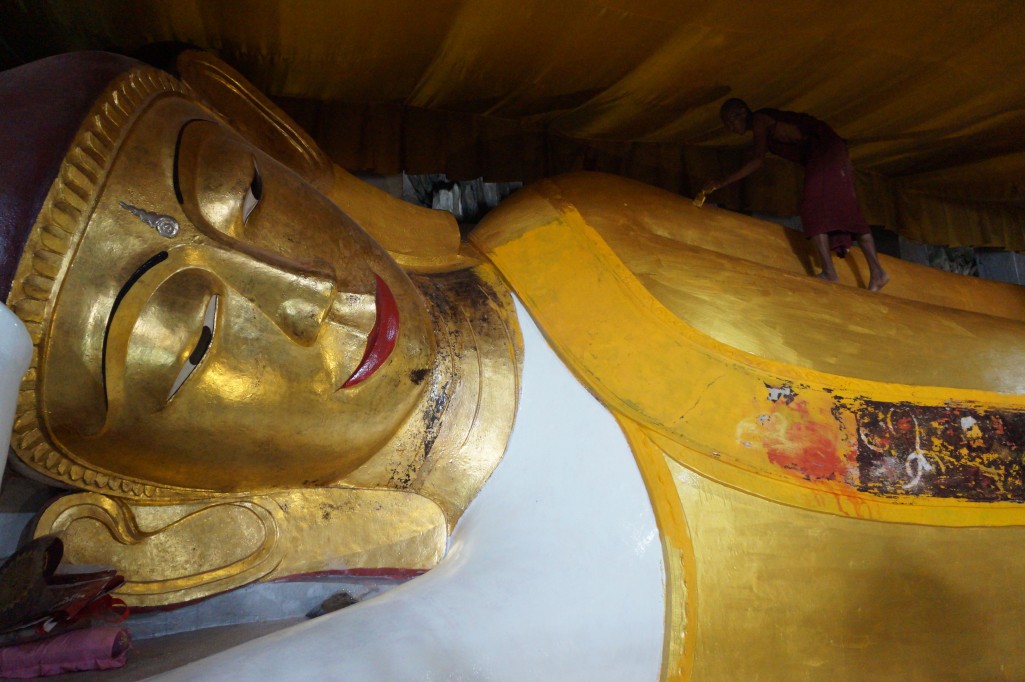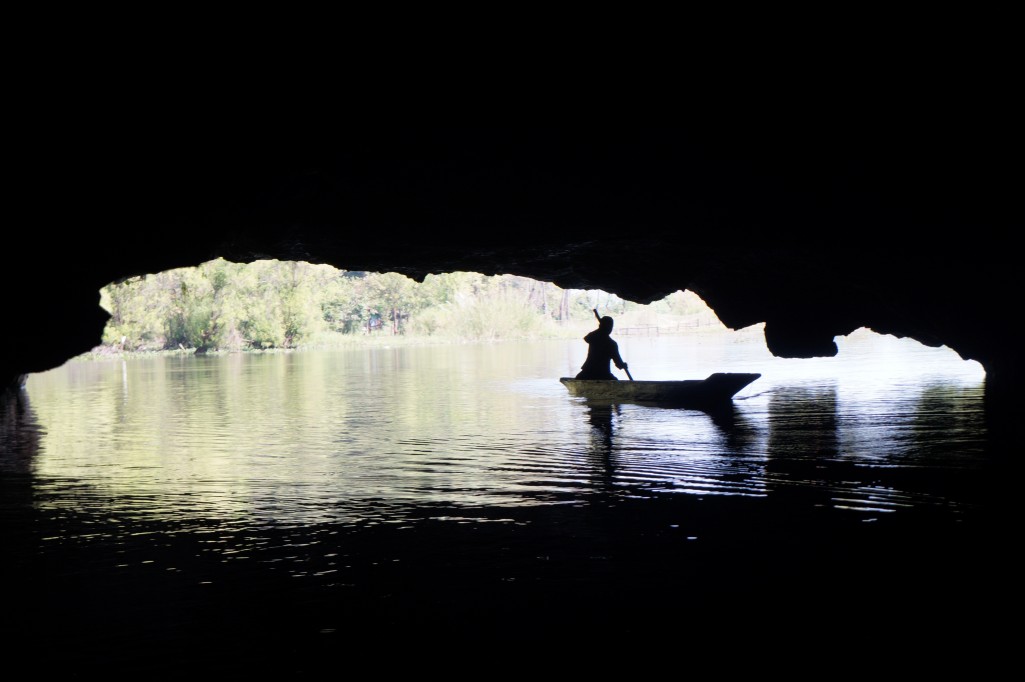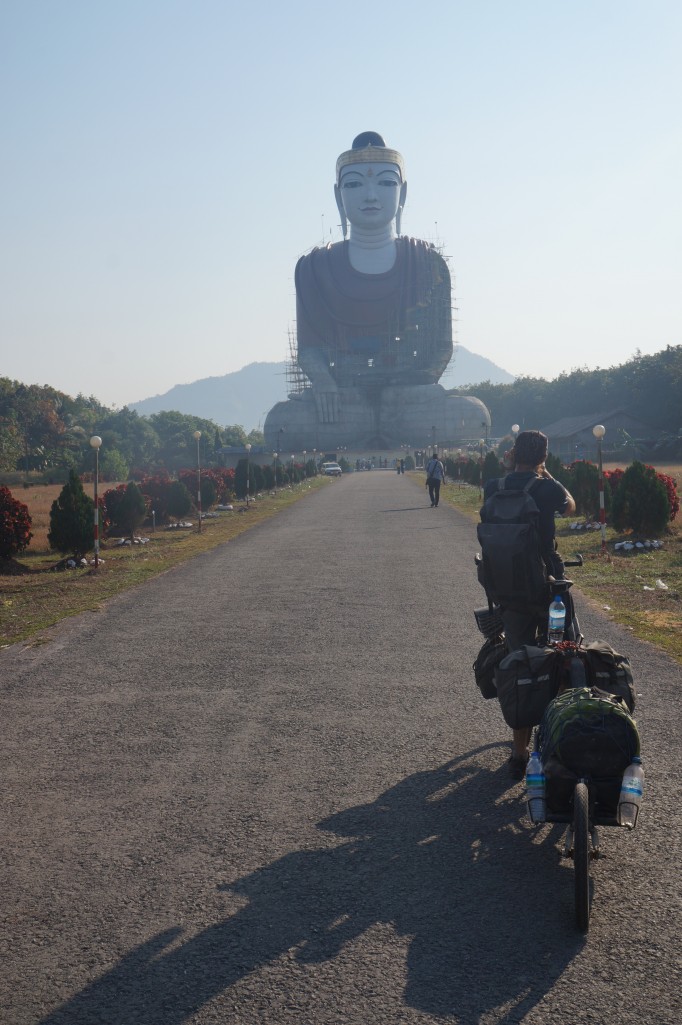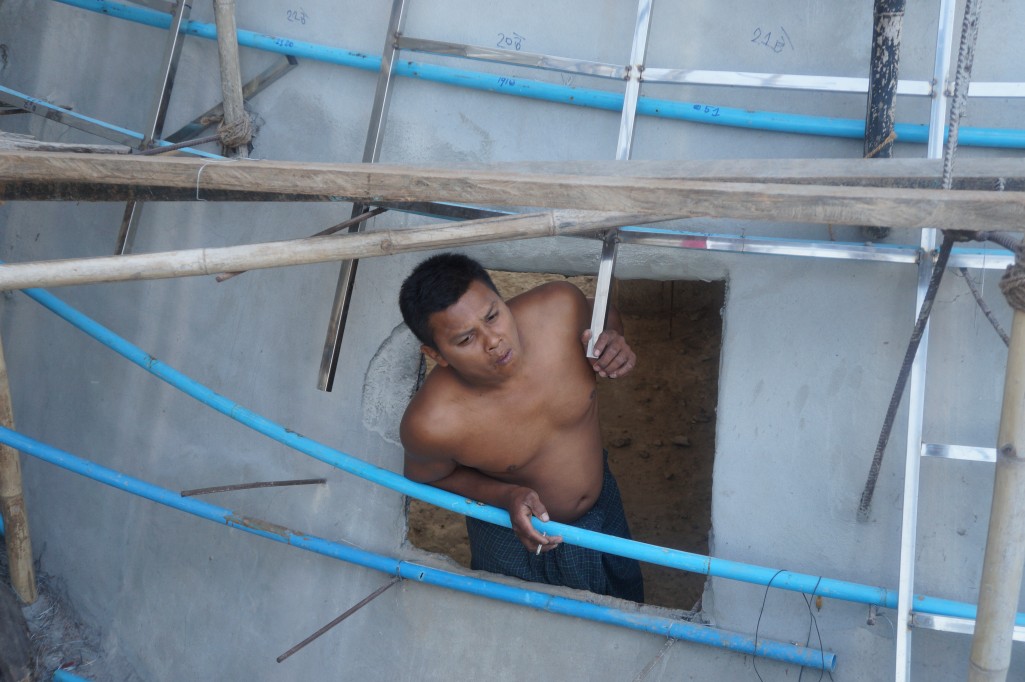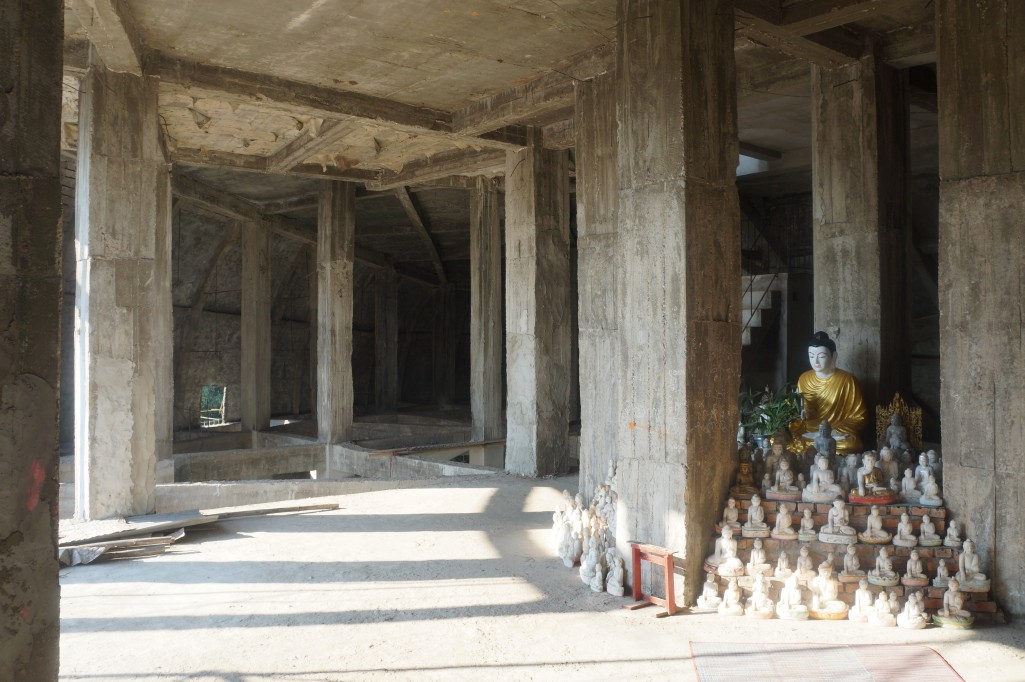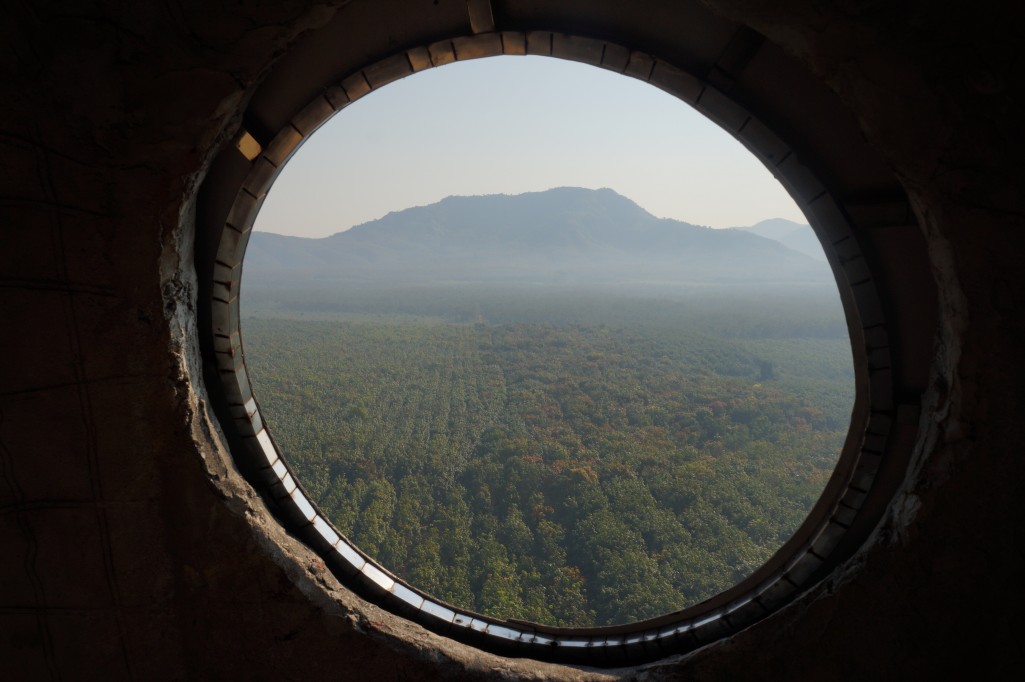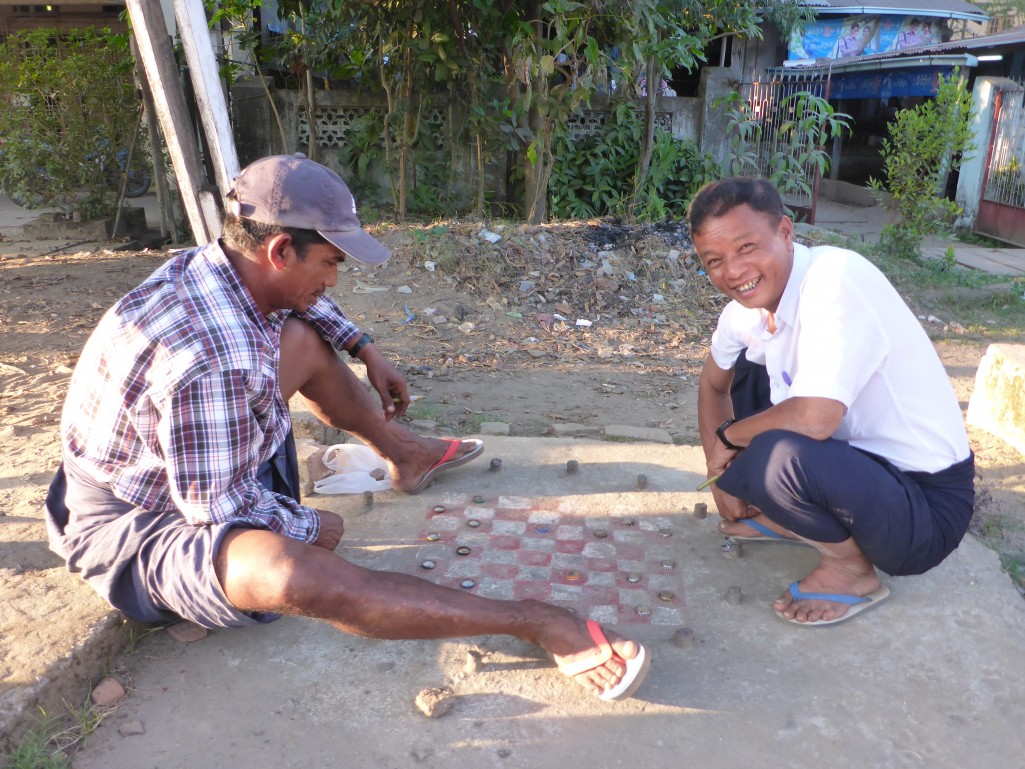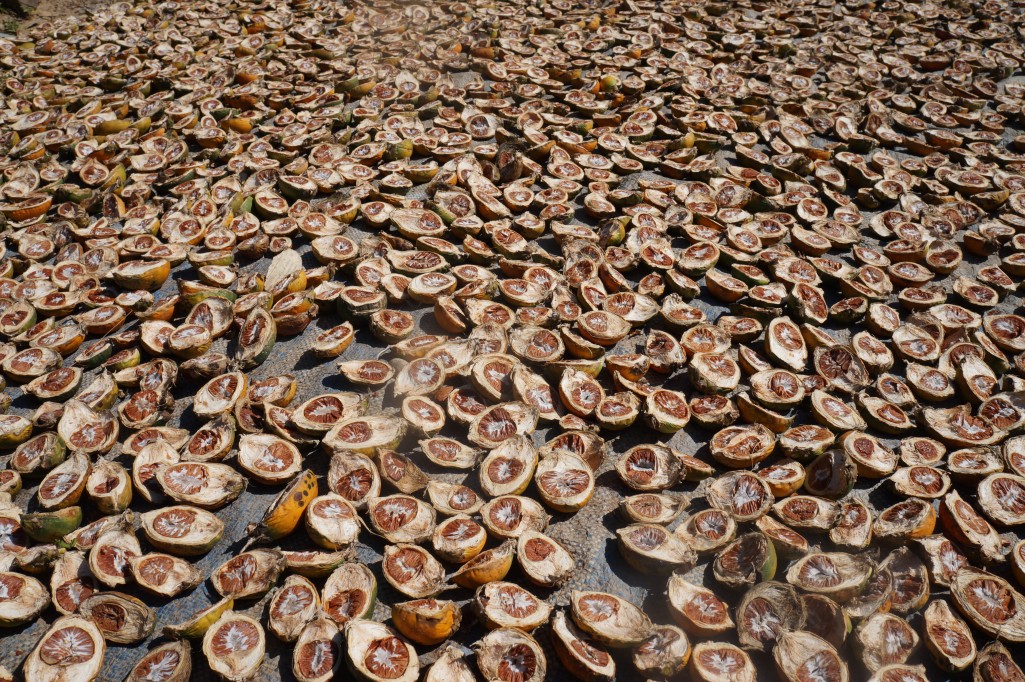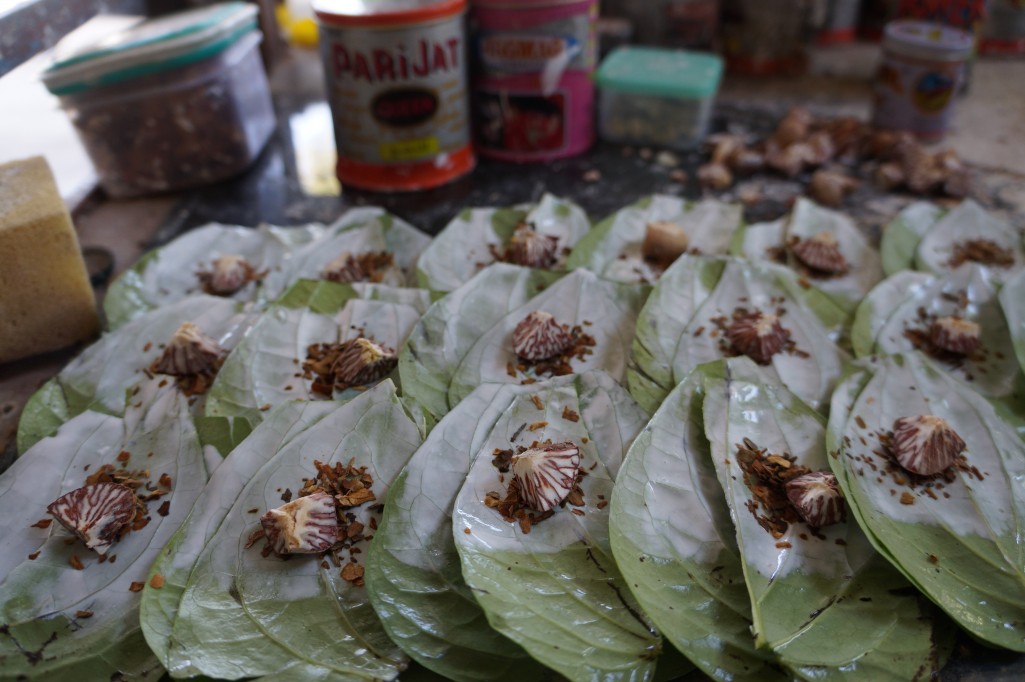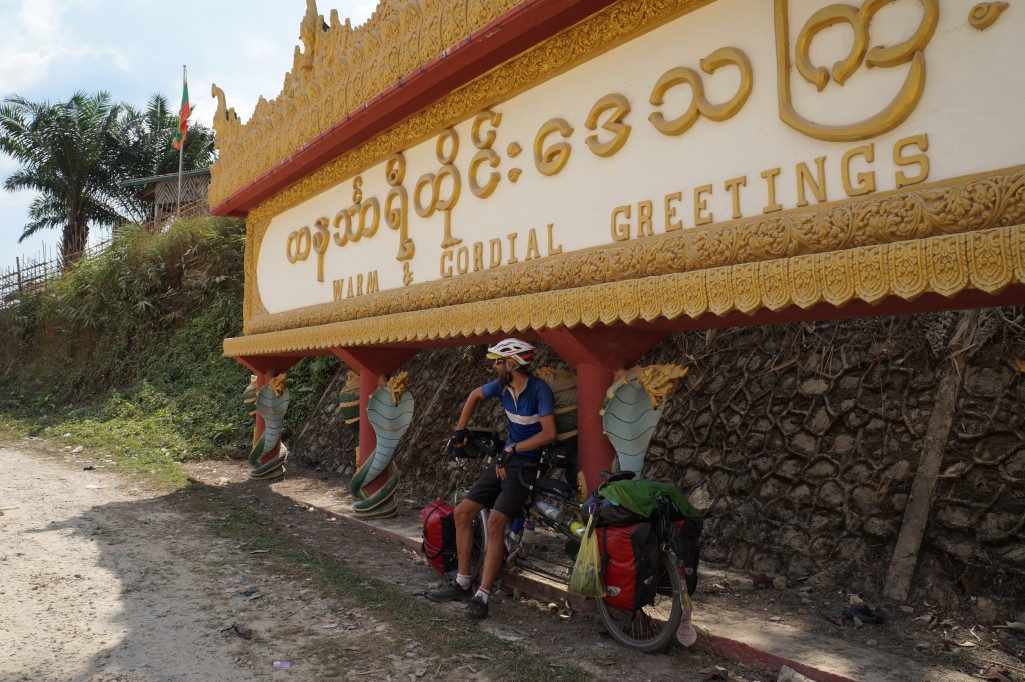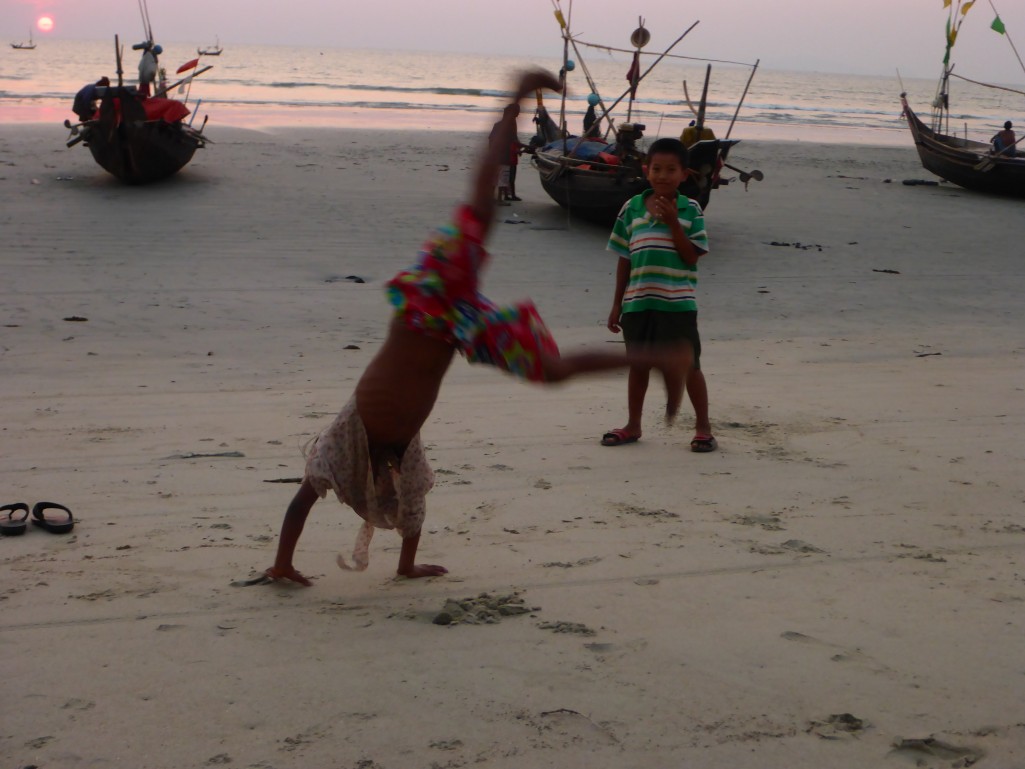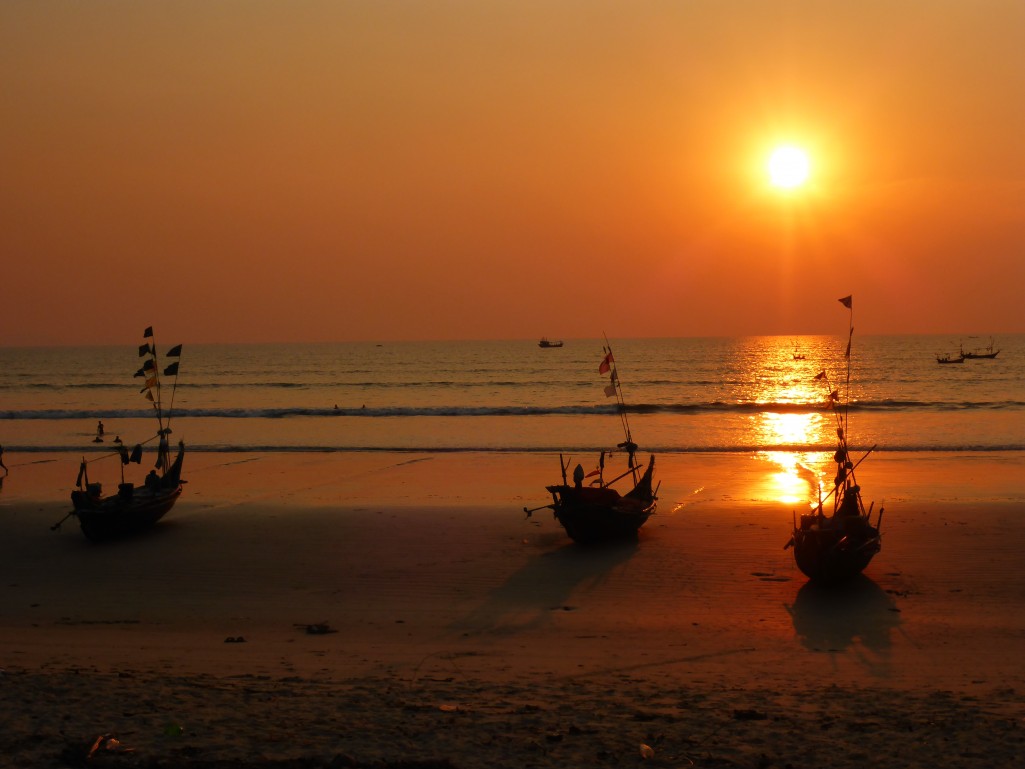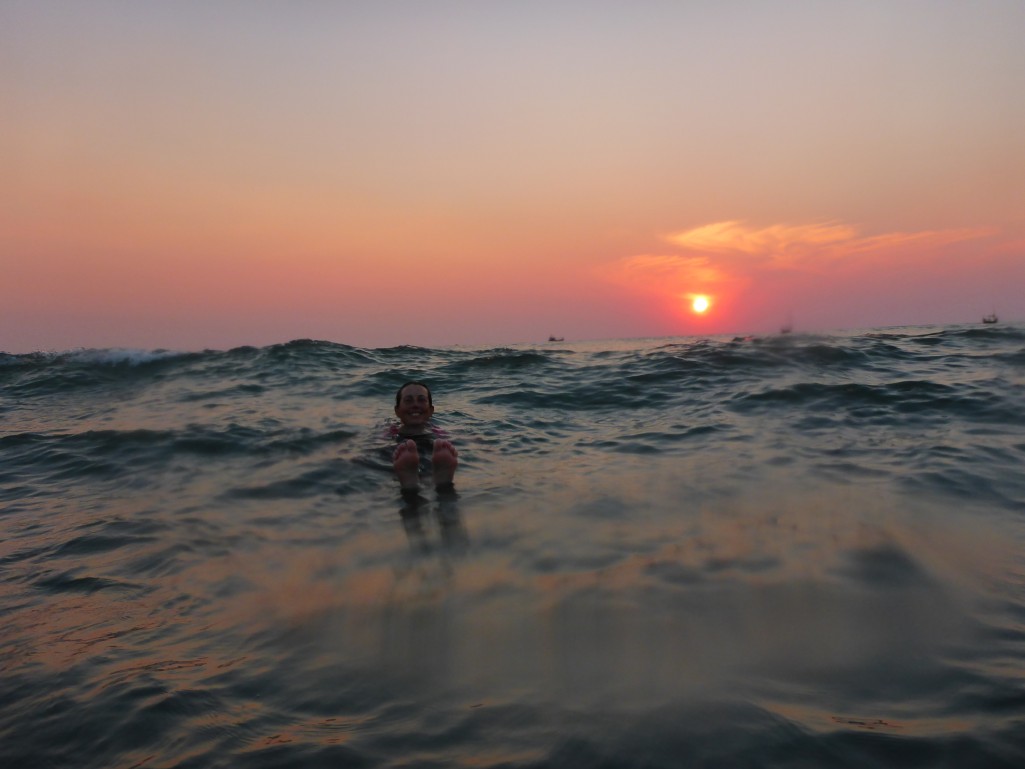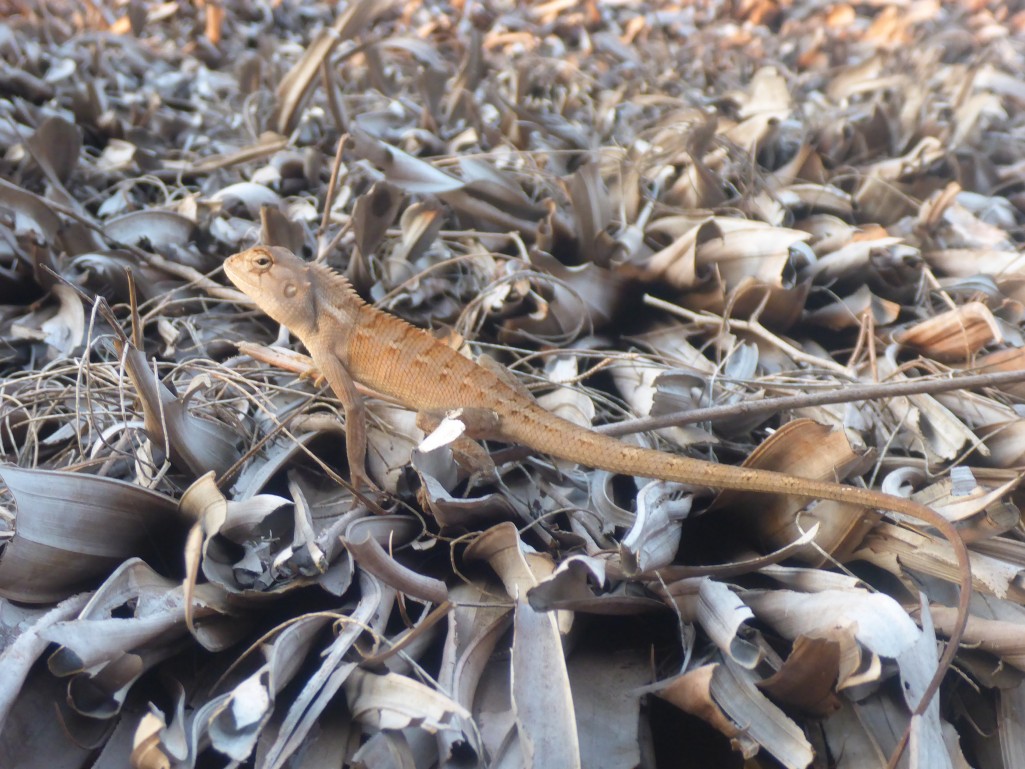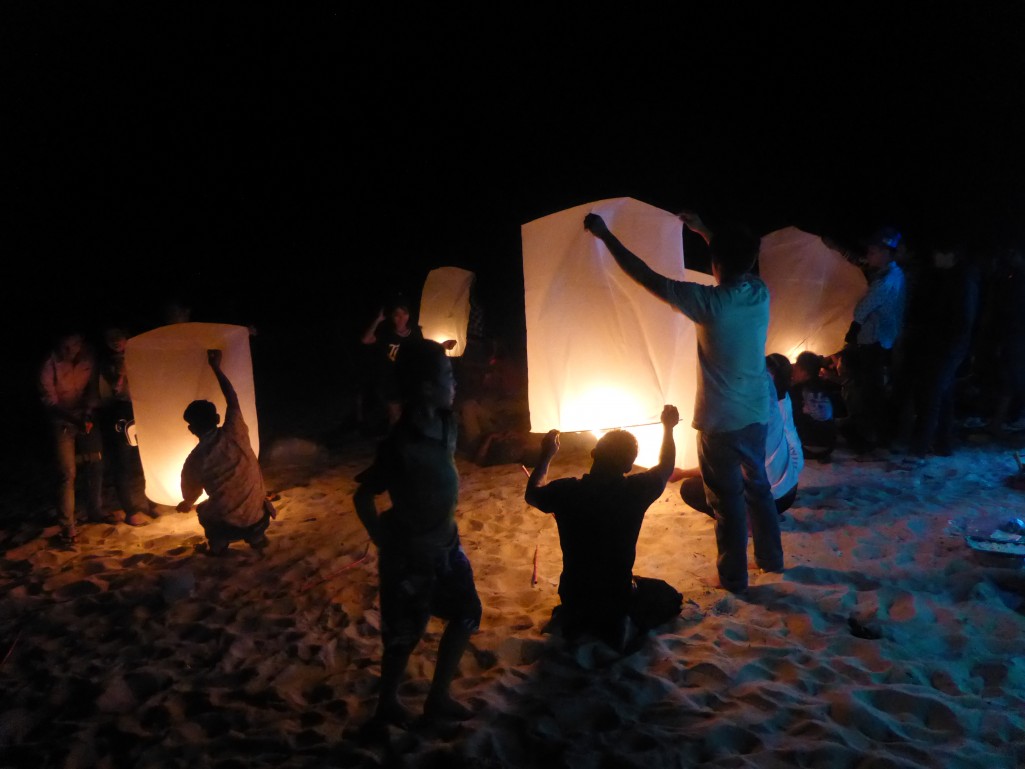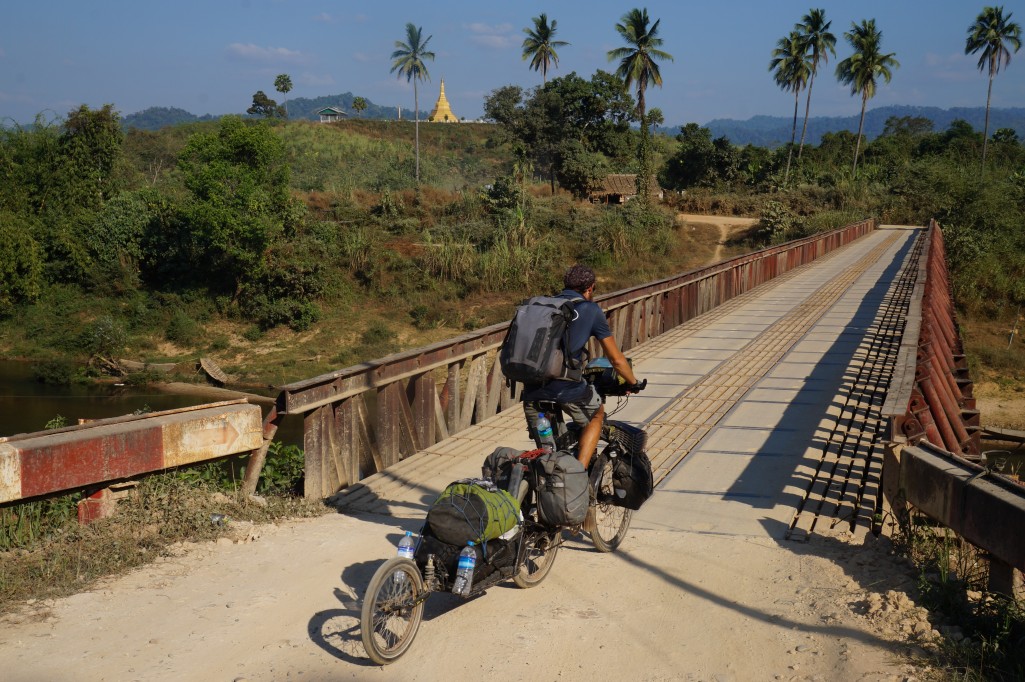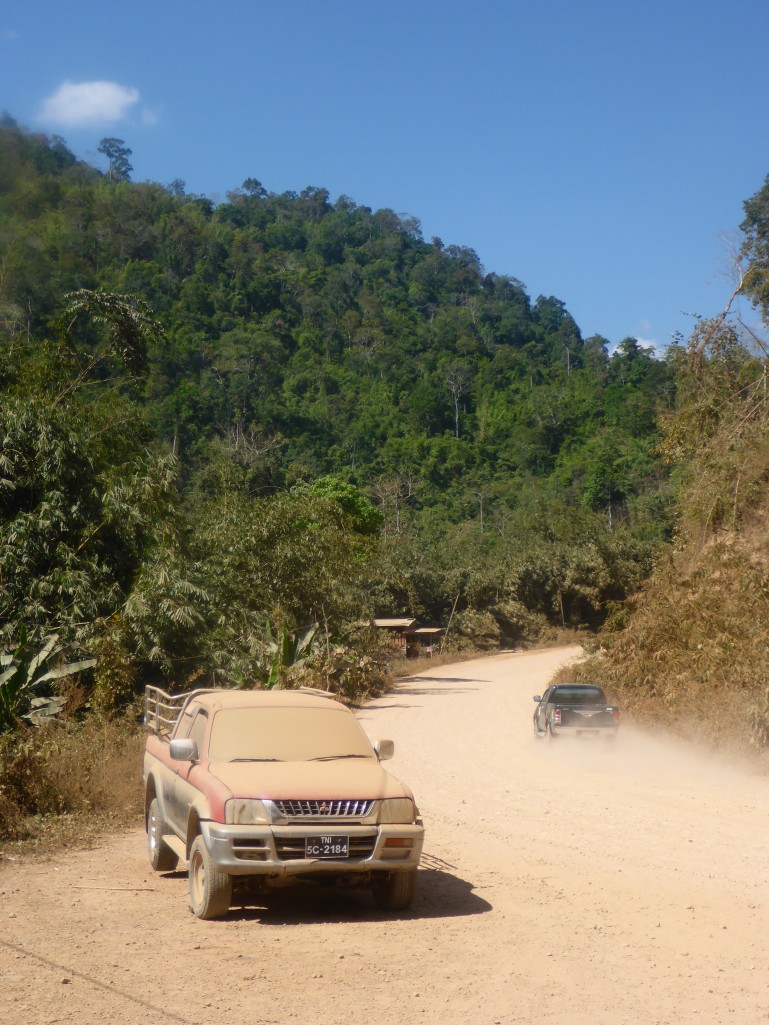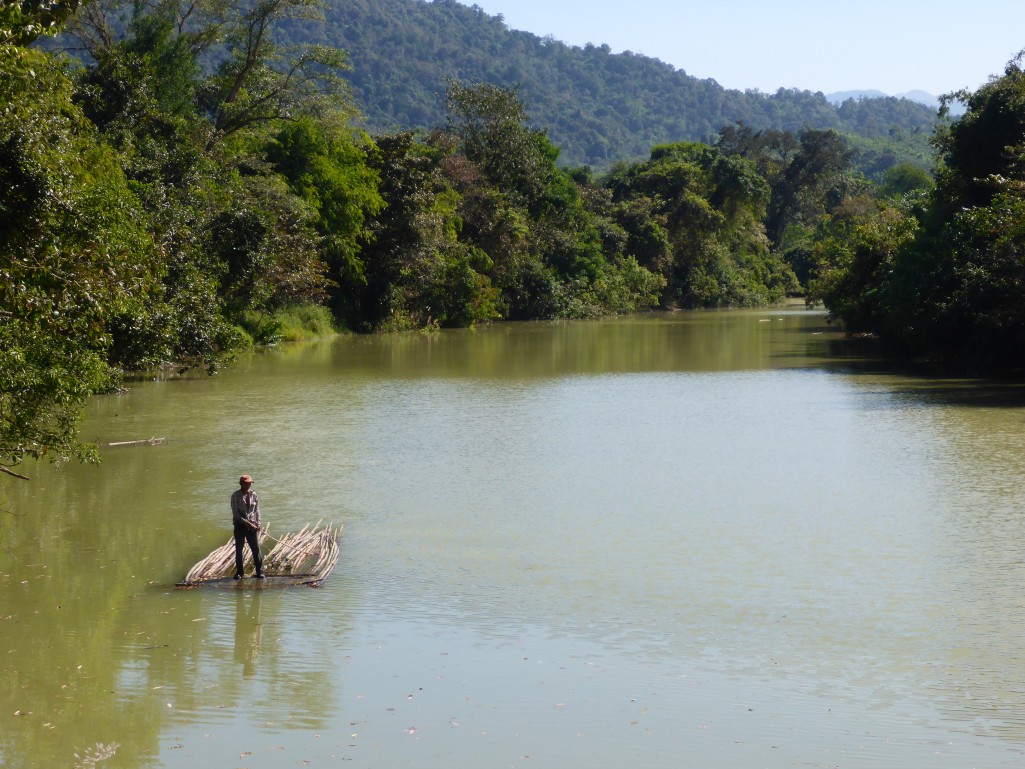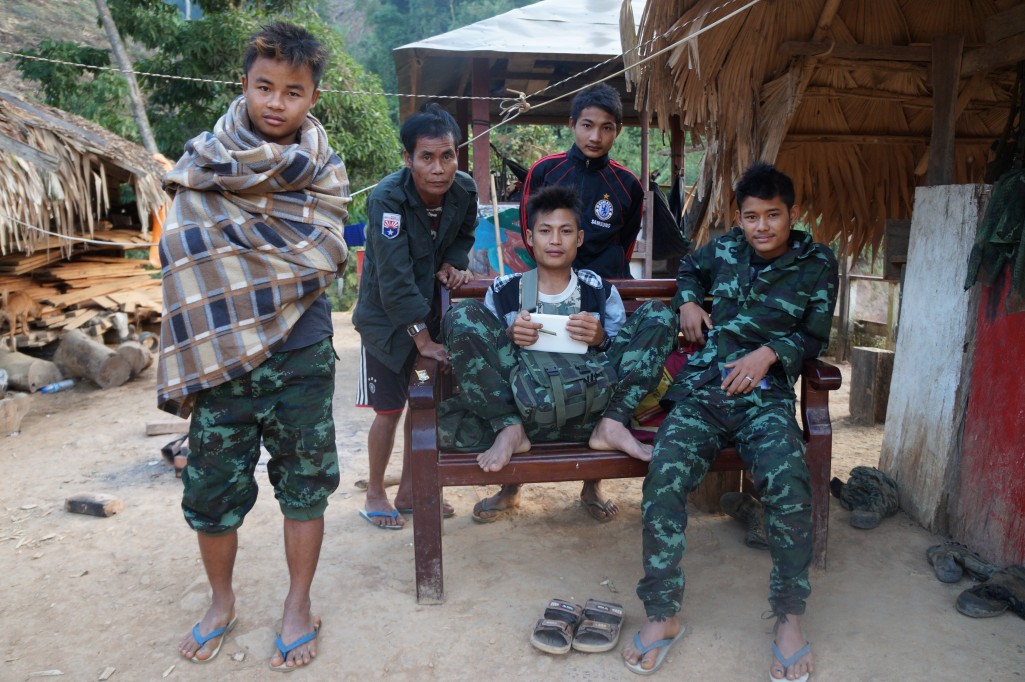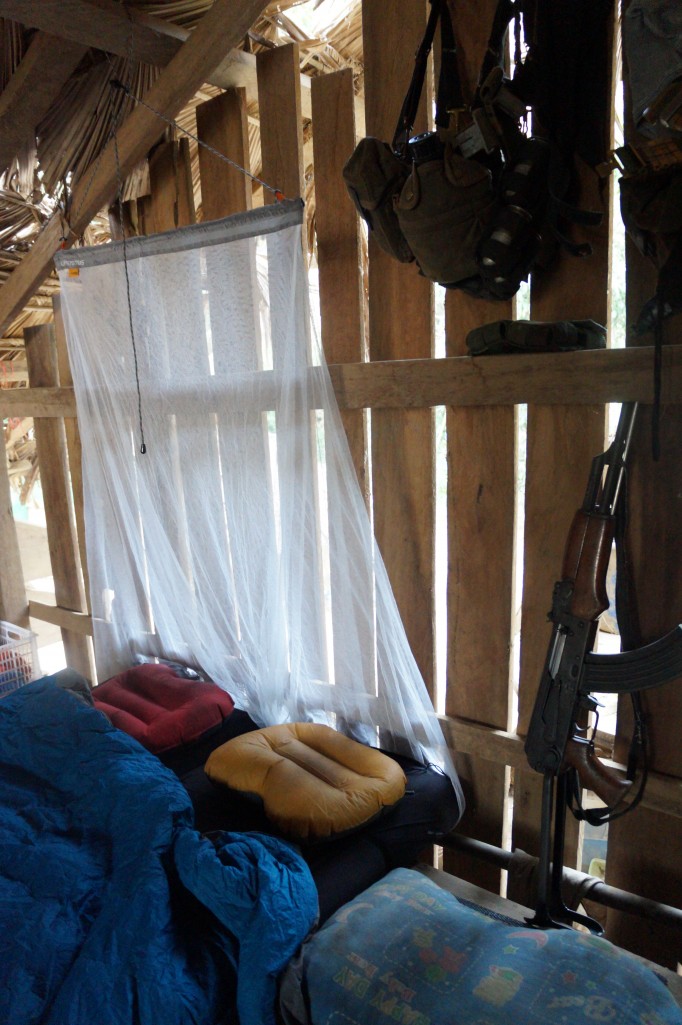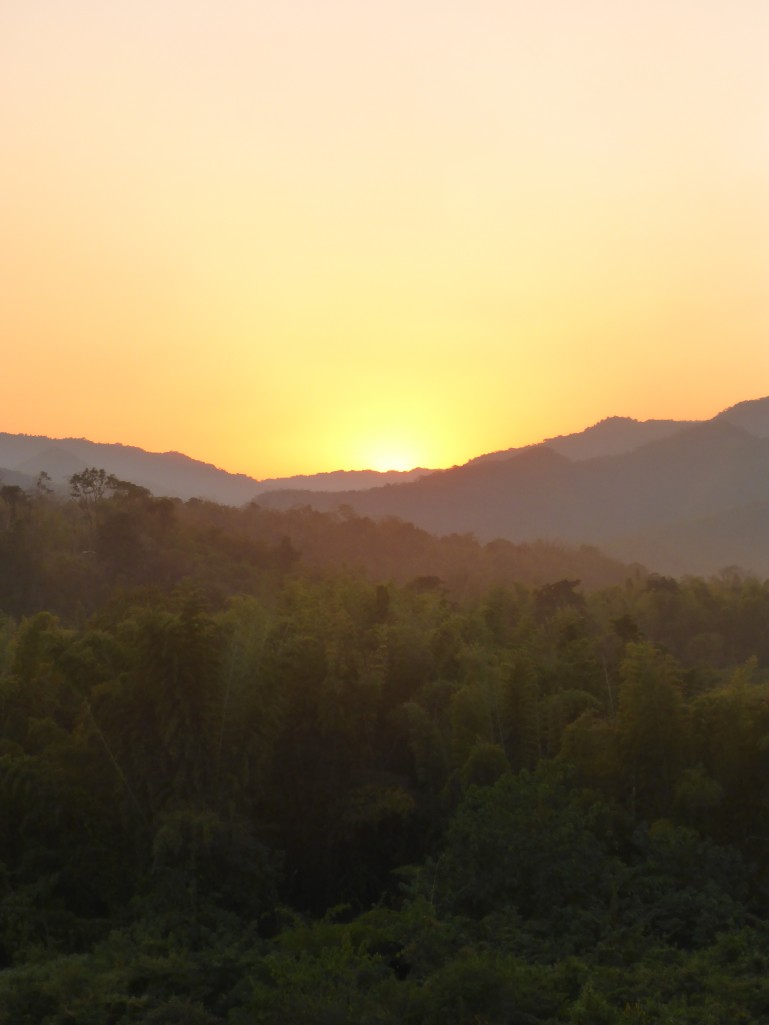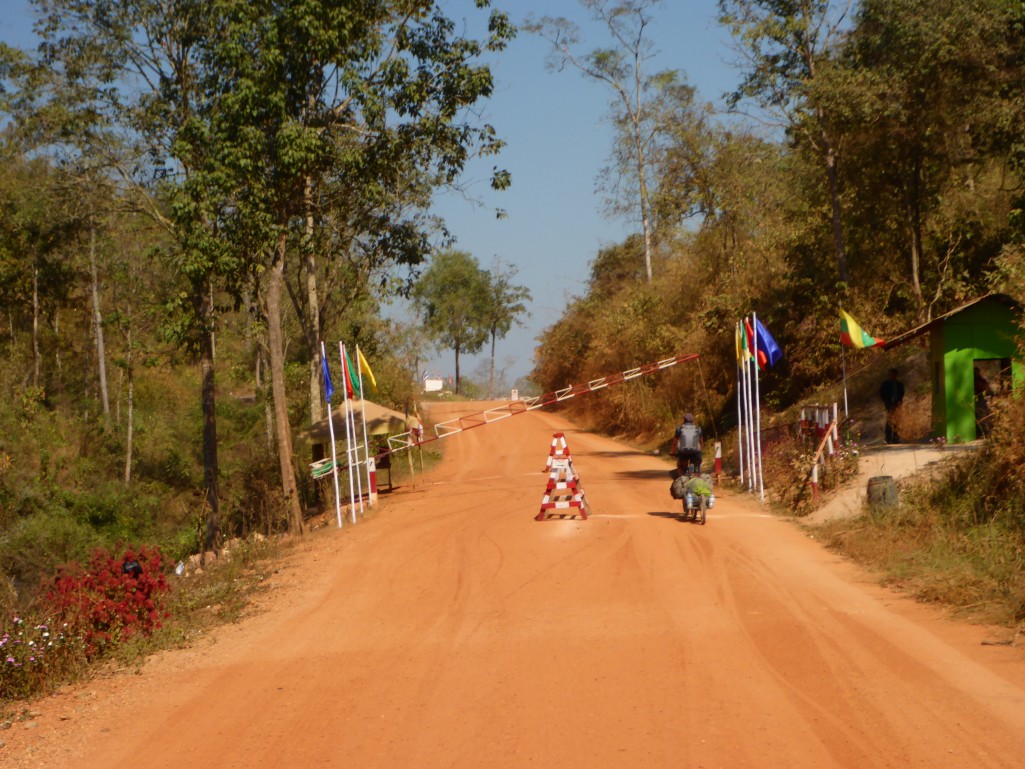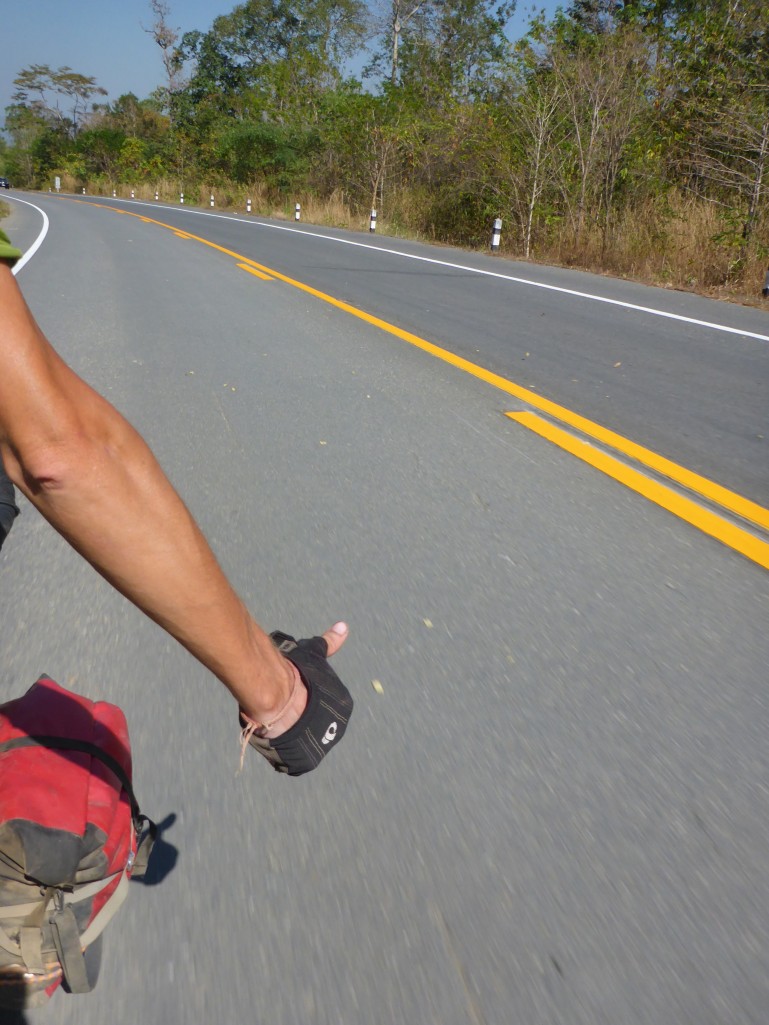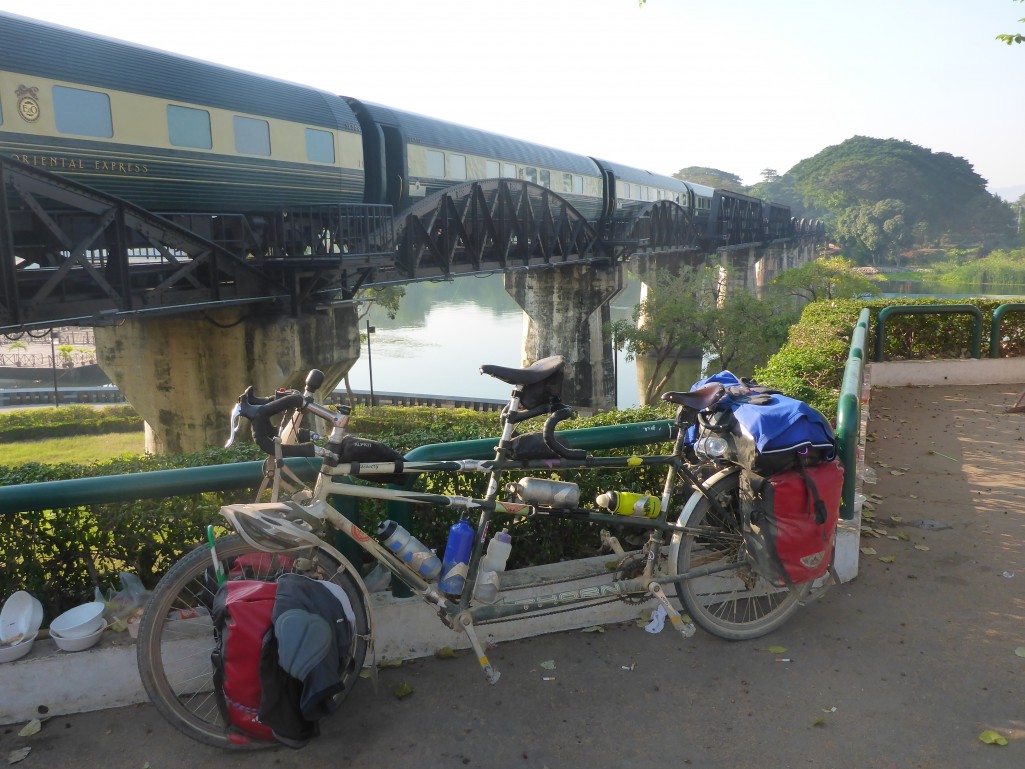Bangkok to Phnom Penh

5th to 19th Jan 2016
As soon as we arrived in Thailand the culinary delights were presented to us from cafes, stalls and markets like a cycle tourist’s dream drive-through restaurant. Spicy papaya salad, pad Thai, seafood, sticky rice, a dozen fruits we couldn’t name blended into a smoothie. This was a country where the time eating could easily be greater than the time spent cycling.
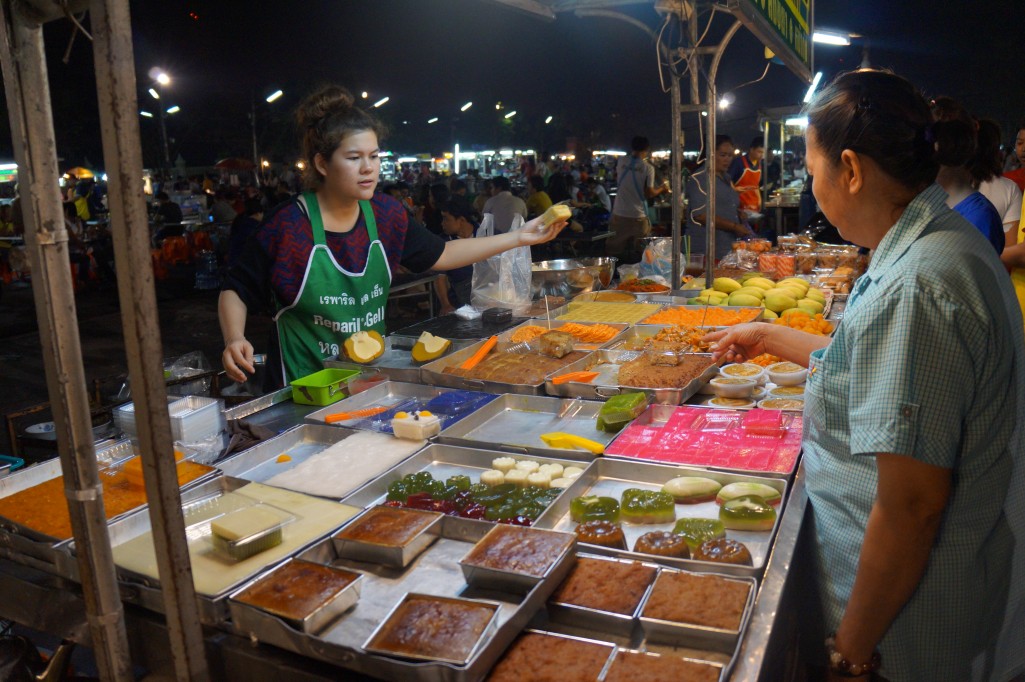
The day before arriving in Bangkok we pass through Nakhon Pathom and by chance come alongside an ancient Vespa with a friendly looking rider on board. This is Shoot, who happens to be a Warm Showers host with a funky bookshop/café and before we know it he’s invited us to stay. The square in front of the huge pagoda is crammed with food stalls and we enjoy perusing and consuming. Shoot then suggests we go out to dinner with his friends. Dinner #2? Who are we to argue!

On full stomachs we eventually speed into Bangkok, a vast and modern metropolis the likes of which we hadn’t seen since Europe. Here we part company with Max whose trip has reached its conclusion and luckily without his wheel disintegrating. After a few days of rest he’ll be on a plane back to Austria to brave the cold and begin dreaming of his next adventure.
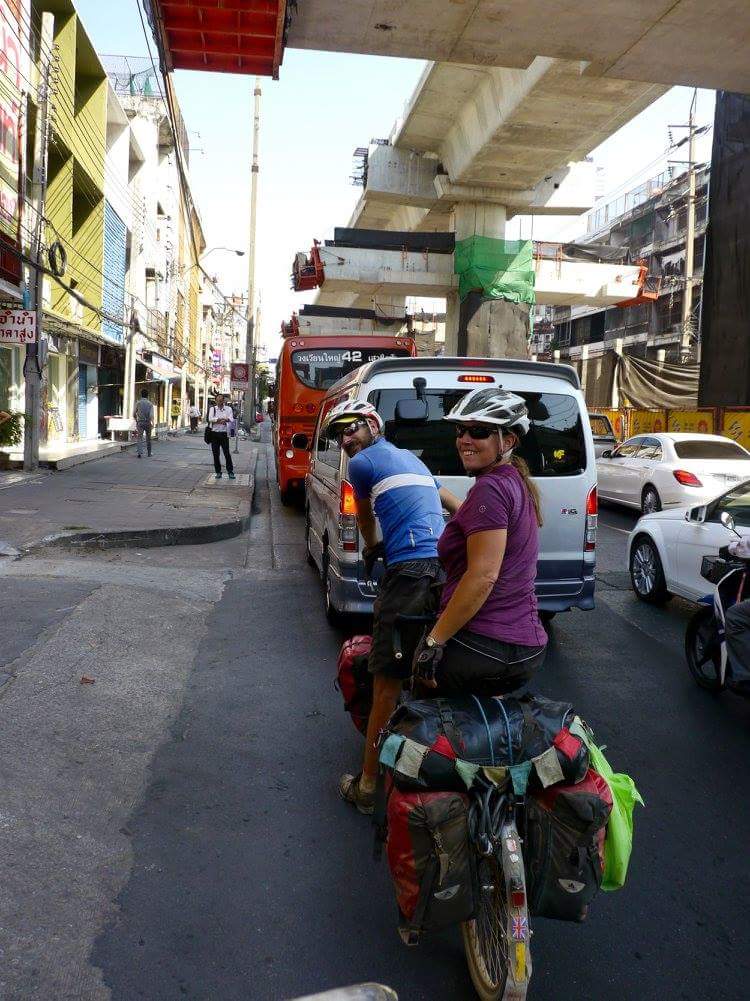

Like any huge city Bangkok promises anything and everything, though here your imagination really is the only limit. Also like any huge city it takes absolutely ages to find what you want. Trying to track down some parts for our rear hub takes two days on the sky train, the subway, taxis and at one point a ride in the back of a pickup with someone who swears he knows someone who can help. All to no avail though, the hub is 16 years old but it’s highly likely the parts I need are somewhere here, I just didn’t blow the dust off the right box in the right workshop. Instead I grab a couple of bags of bearings and accept it will need a bit of TLC to keep it going for a bit longer, then order the parts online to be picked up in Hanoi. Our front panniers have also just about made it but this is the end of the road for them. The Vaude dealer doesn’t have any in stock but an email to the main office in Germany results in some warranty replacements which are sent to the UK for later collection. Ortliebs are much more readily available so we pick up some in a fetching bright green instead.

Our host in the big city is Alex, who has shared many a perilous bus journey and roach infested guesthouse during travels with my brother. In return for letting us stay I introduce him to the joys of the Hash House Harriers who of course have a Bangkok division. Urban running doesn’t get much more diverse with turns through tobacco warehouses, down busy tourist streets and past overly friendly ladies in doorways. Alex thoroughly enjoys the run so may have found a new weekly activity.
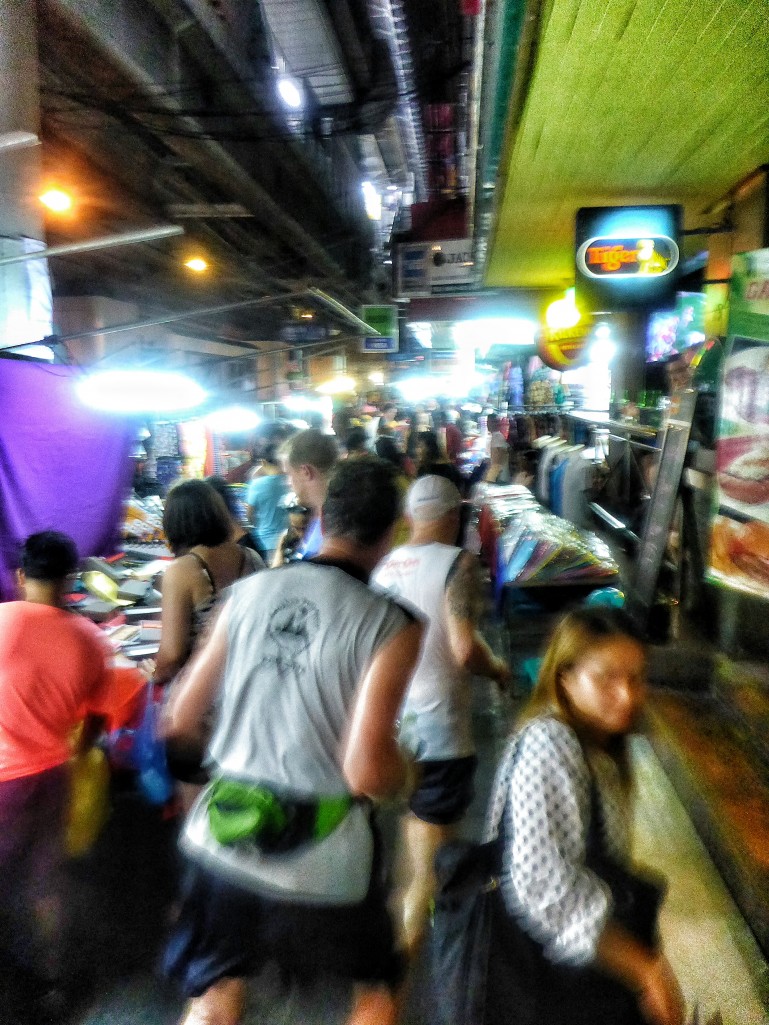
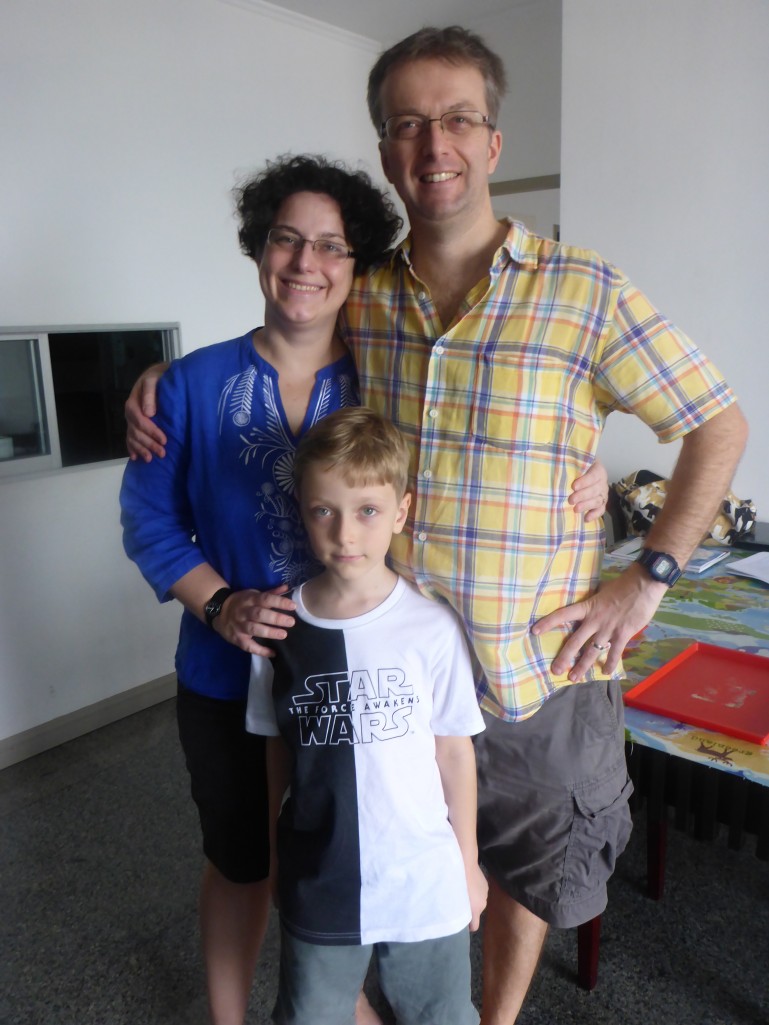
After four days, with all errands run, or at least attempted, we’re good to go again and find the ride out of the city busy but otherwise uneventful. Certainly far from the carnage and certain death that a few people had promised us. On the way we catch up with fellow cycling traveller Pete, who we last met in Bishkek and is now looking for gainful employment here in Thailand to postpone a return to London.
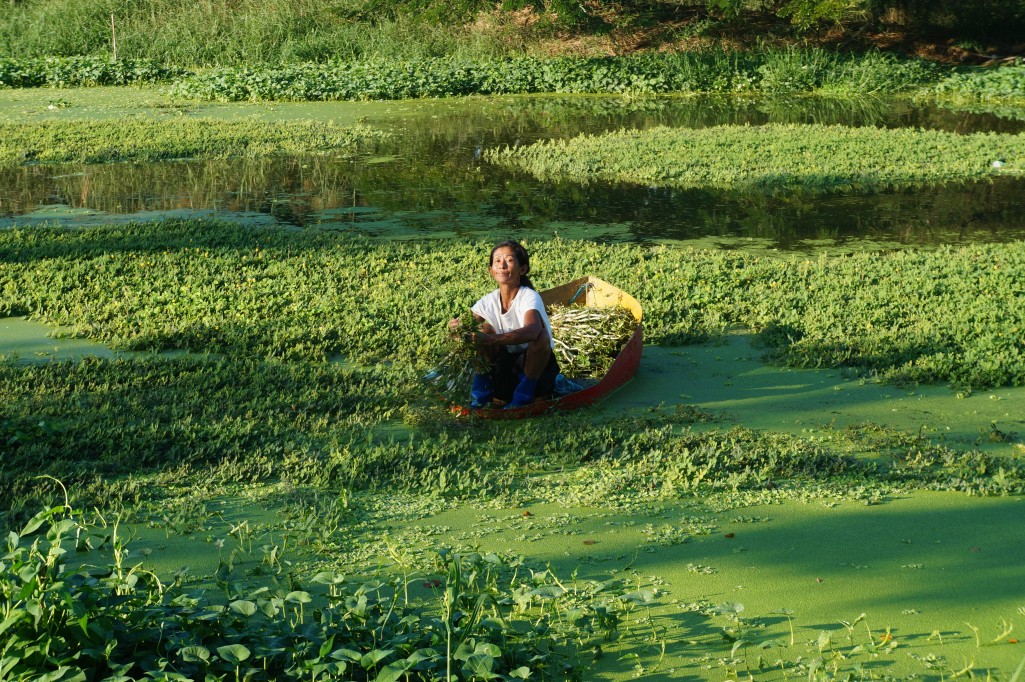
It’s flat, fast and fairly dull for the two days that take us southeast down to the coast. We get our heads down and get the job done, fueled on M150 energy drink. The monks here in Thailand are just as welcoming as in Myanmar, providing us with floor space in temples each night. There’s been a costume change though and they now wear orange instead of maroon robes, often with a set of pockets across the front for holding their smart phones and cigarettes.

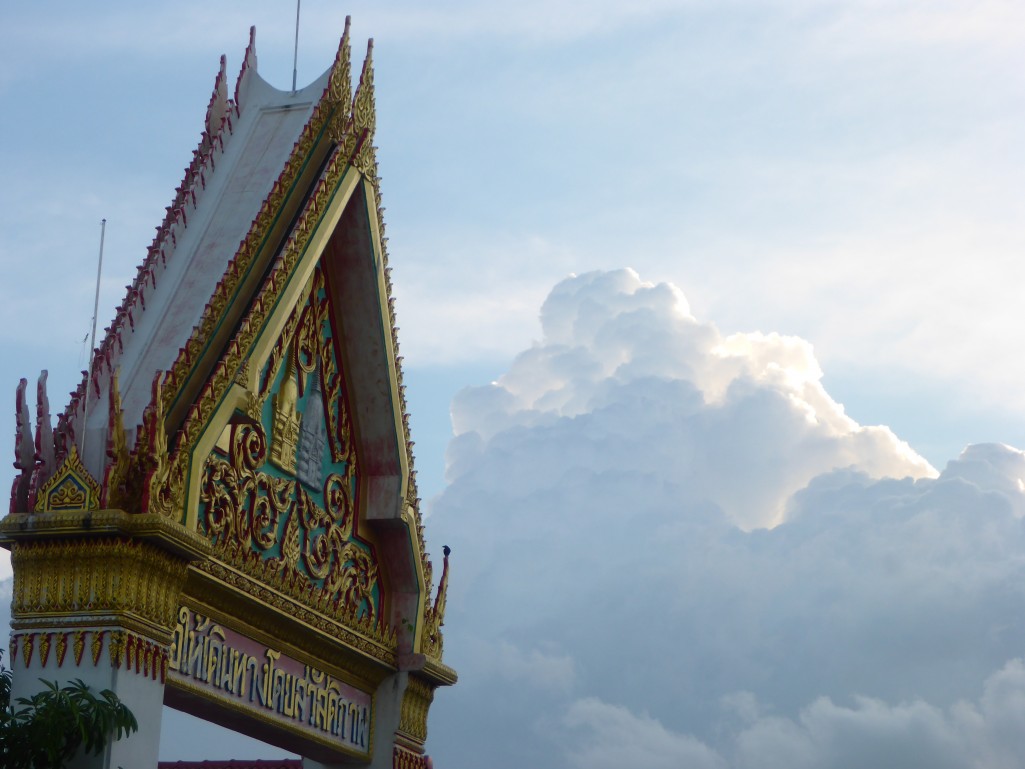
Then as the Gulf of Thailand comes sparkling into view we turn off the main road and a small brown sign announces we’re on the ‘Scenic Route’. Not only does the outlook improve with the road weaving through farmland, forests of rubber trees and past beaches but we also get a cycle path all to ourselves. The only blight is the abundance of prawn farms, polythene lined ponds with aerators churning away where the latest batch of Waitrose tiger prawns are being cultivated. It’s the latest profitable farming fad for the region, replacing the mangroves, and with the salt water and antibiotics contaminating the land it’s likely to be the last.
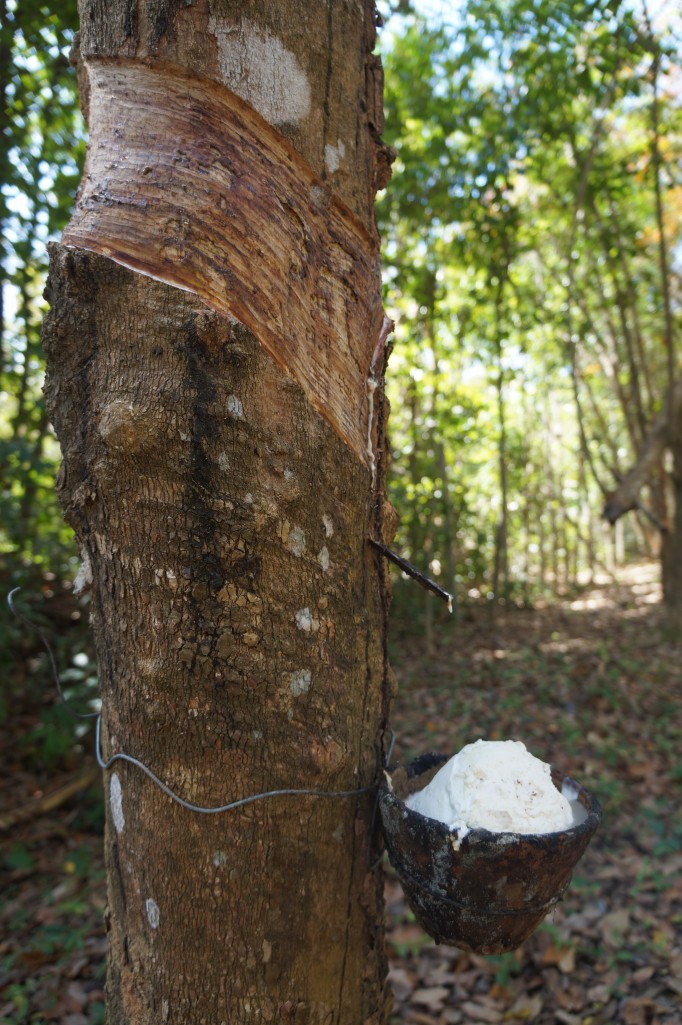
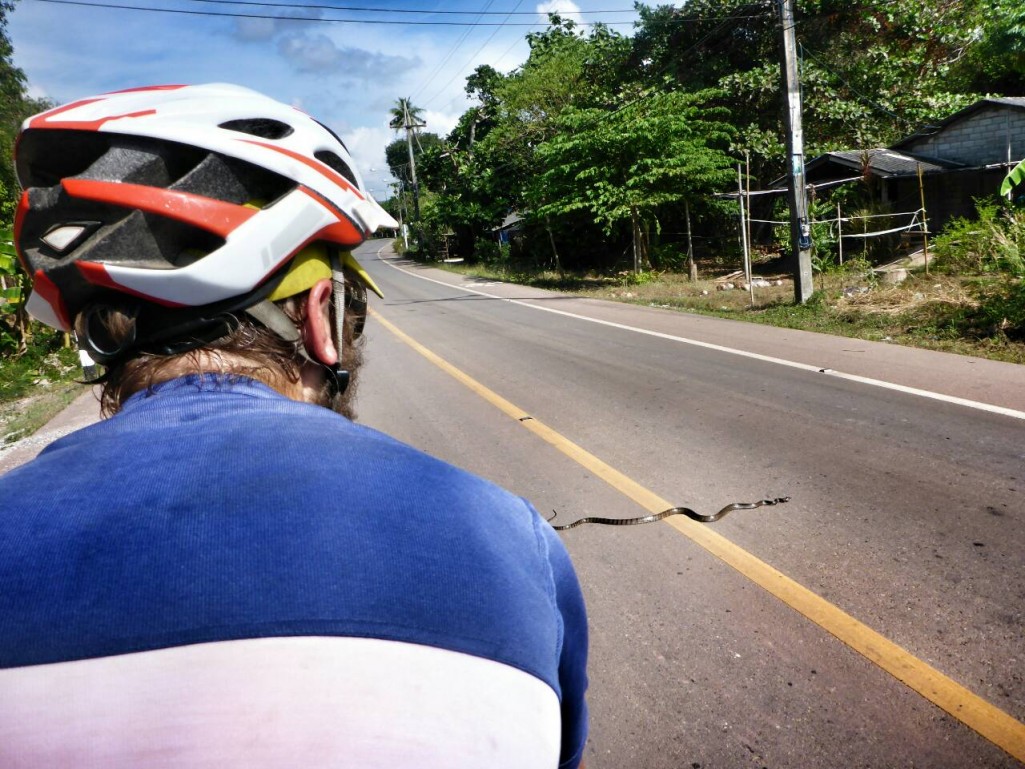
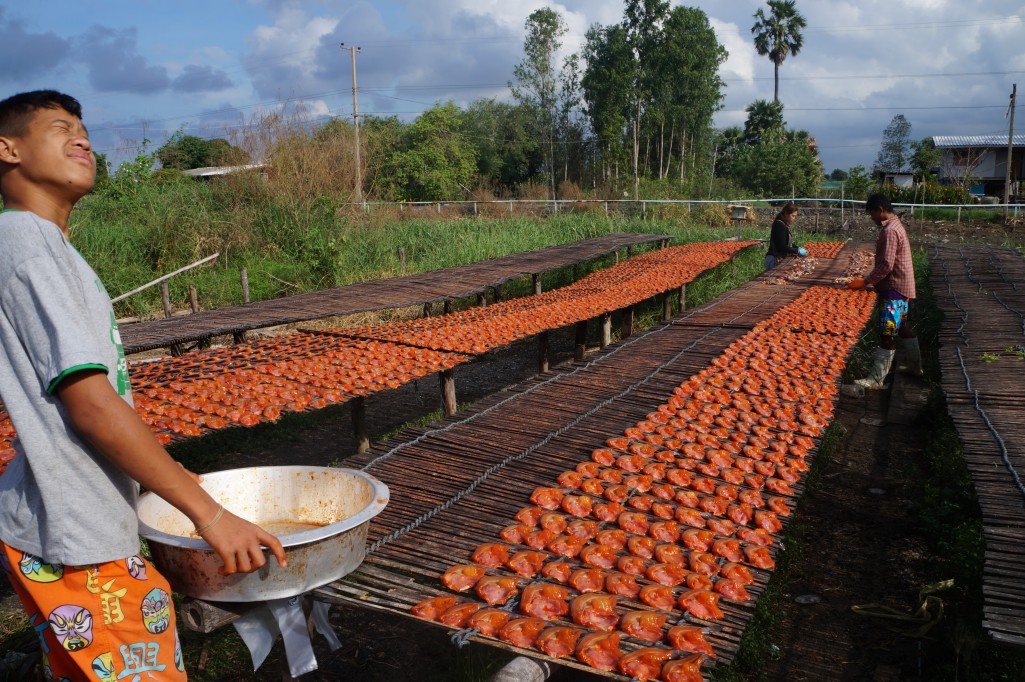
The sea is as warm as bath water when we finally arrive at a beach for a swim nicely timed before lunch. A welcome change of scenery after the dual carriageway blast from Bangkok and worth the effort to get here quickly.
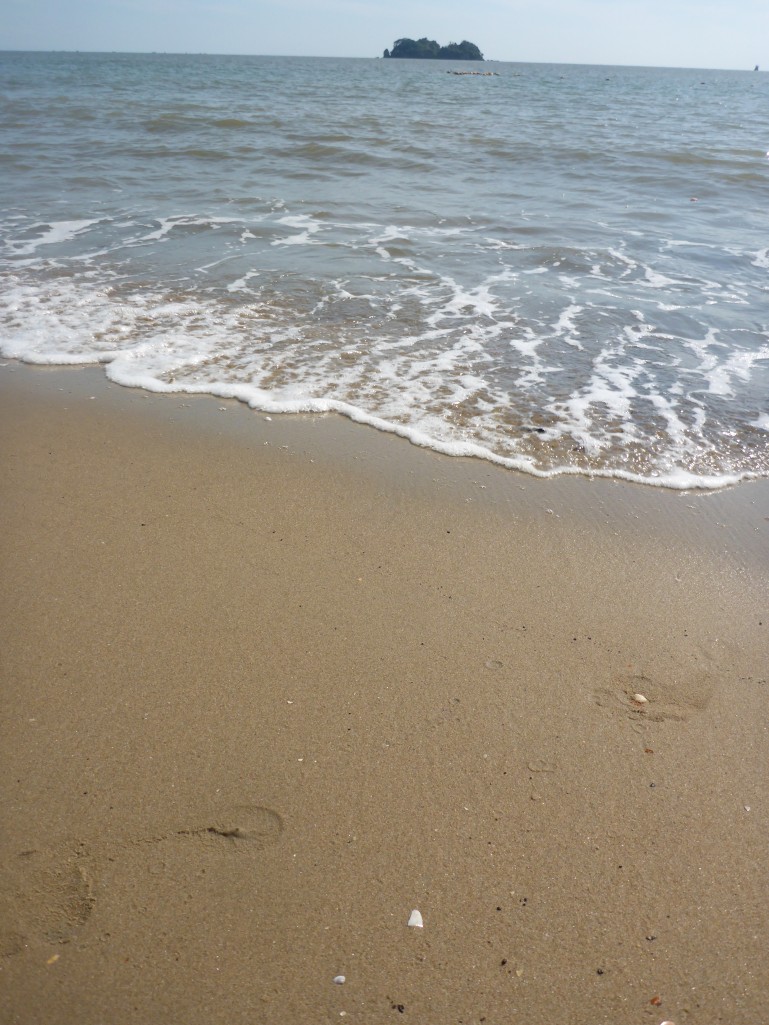
As the light of the day begins to recede some loud music attracts us to a temple and after a chat with one of the monks and settling in we go to investigate what all the noise is about. It’s a funeral in an adjacent building.
At the front some monks are chanting, a large gathering of people watch the proceedings while others are tucking in at a generous buffet. The general atmosphere is upbeat no doubt inline with their beliefs that the body is just a vessel and the man’s soul has now moved on to its next journey and life. This is a celebration rather than a mourning. The daughter of the deceased spots us and invites us to join the feast. Now we’re all for getting involved with local celebrations but gatecrashing a funeral seems a bit much so we offer our condolences and return to our floorspace in the main building.
But in the morning it’s all still going on and again we’re invited to join them so we pay our respects by lighting some incense sticks then sit awkwardly with plates that are quickly loaded up by the generous hosts. I hope this is what he would have wanted.
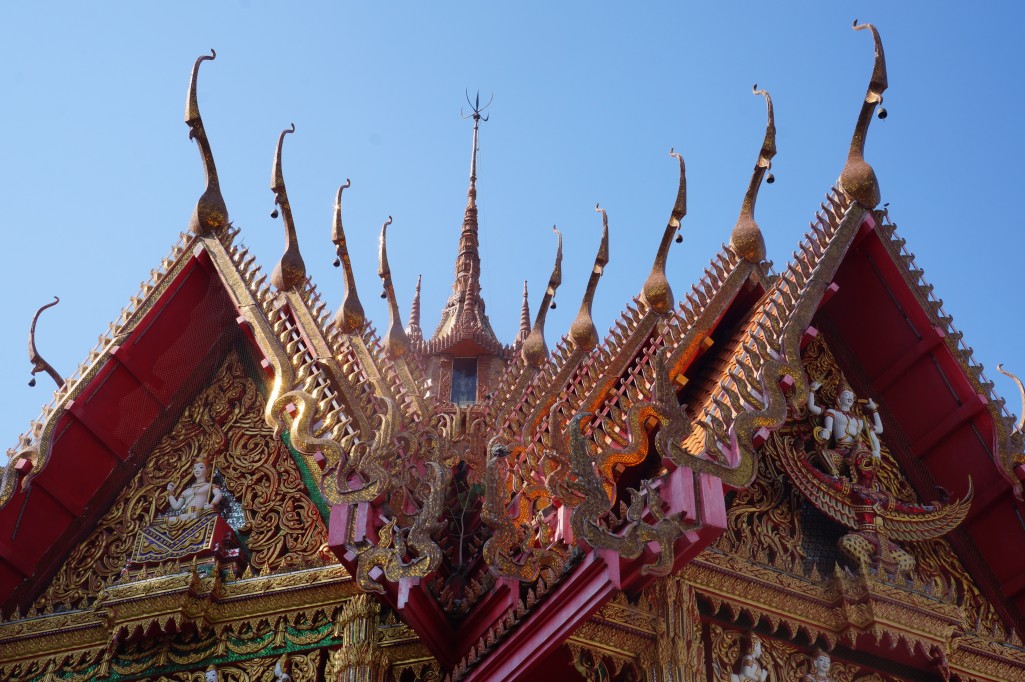
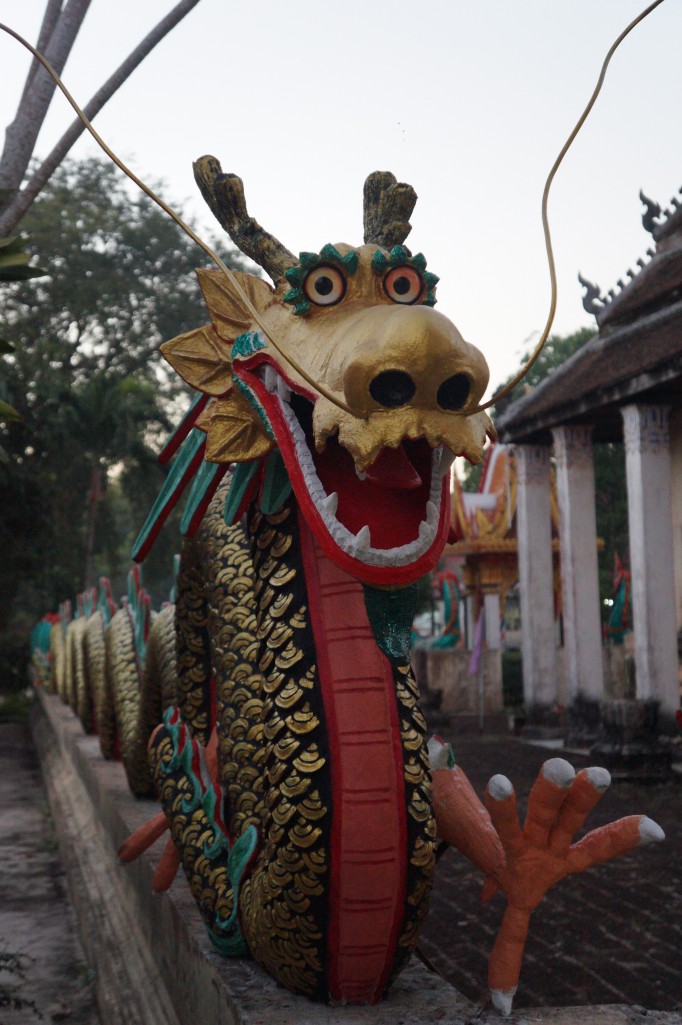
We’re constantly surprised by how affluent a country Thailand is and like any modern society bikes become playthings rather than just essential forms of transport. Middle aged men in lycra potter around on smart looking road bikes and super-fat tyred mountain bikes, giving us a smile and a wave as we cruise past. The roads are good for cycling and we see nothing of the bad driving that gives Thailand the title of the 2nd worst country in the world for traffic accidents (after Libya). Apparently 80 lives are lost every day, 16 times more than the UK.
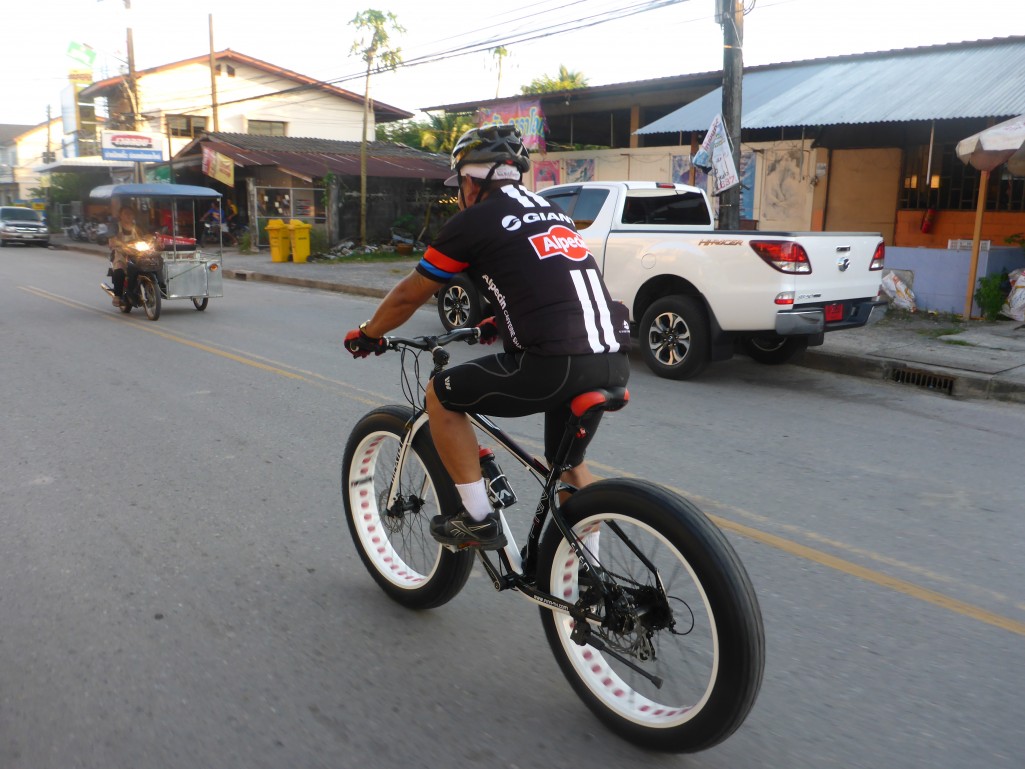
It’s hard to travel far along the coast of Thailand without finding an island so we feel we ought to hop onto one on our way through to see what’s all the fuss is about. Koh Chang is a short ferry ride from the mainland and when we disembark two things quickly become apparent: the hills are steep, really steep, and the island is packed with people, really packed. Hired scooters weave all over the roads while pick-up trucks of backpackers try to squeeze past on blind corners. Not quite the paradise at sea that we had envisaged.

We somehow find a spot for the tent between a reggae bar and a pedicure salon on a rare patch of undeveloped land with a sea view. We find it hard to settle for long in this kind of place. Perhaps we’ve been spoilt by the tranquility and beauty of our many previous camping spots or we’ve become travelling snobs and want it all to ourselves. Either way one night of Thai island life is enough.
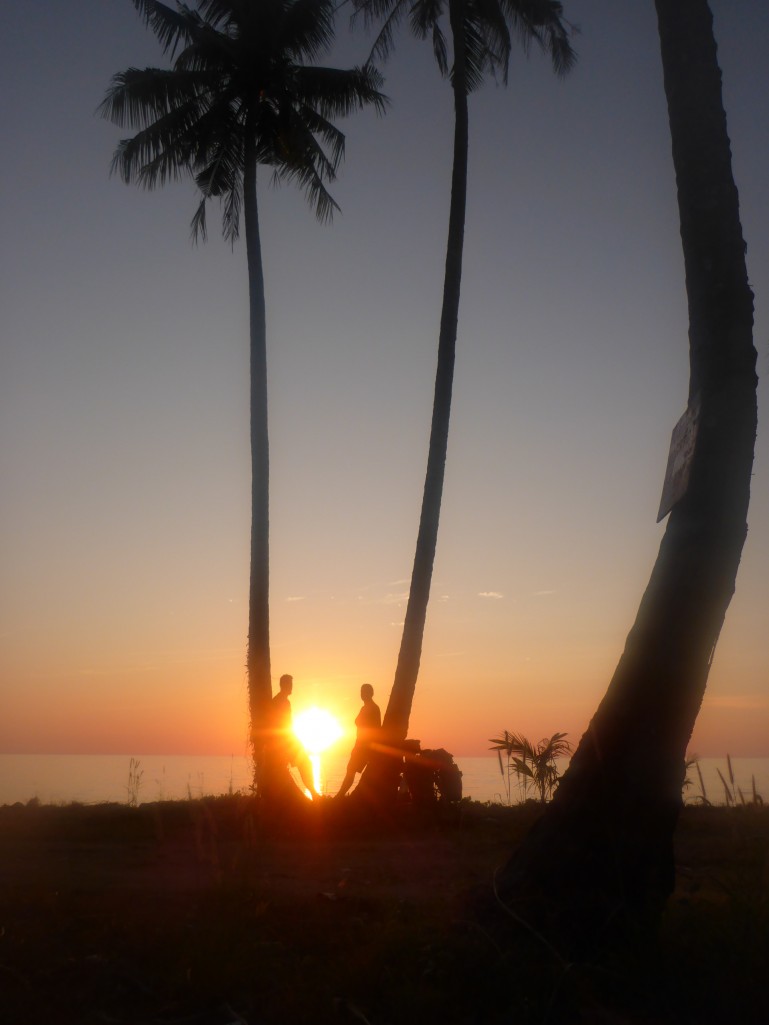
On the ferry back to the mainland we meet two brazilian cyclists, Fabiano and Flavia with a very sad story. After months of saving for a year long trip they were about ready to set off when the Brazilian Real collapsed. This halved the value of their savings and so 12 months on the bikes had to become 6. Undeterred, they are about to return home, earn more cash and try again. We wish them better luck for their future travels.
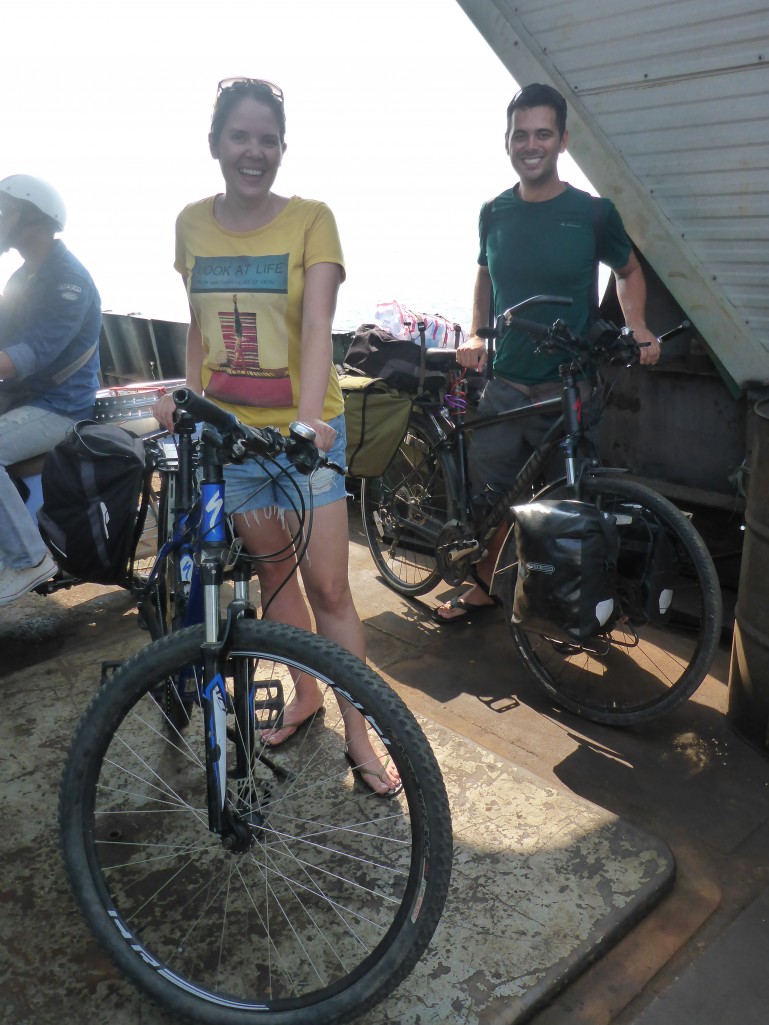
Thailand squeezes down to a narrow strip between Cambodia and the sea as we follow the mainland coast again, at one point only 450m wide. It’s much quieter here and a more secluded beach front provides our final overnight stop before the next border crossing. The nights have been warm and dry for weeks so we pitch the tent without the waterproof fly sheet for the first time. Of course it rains at midnight.
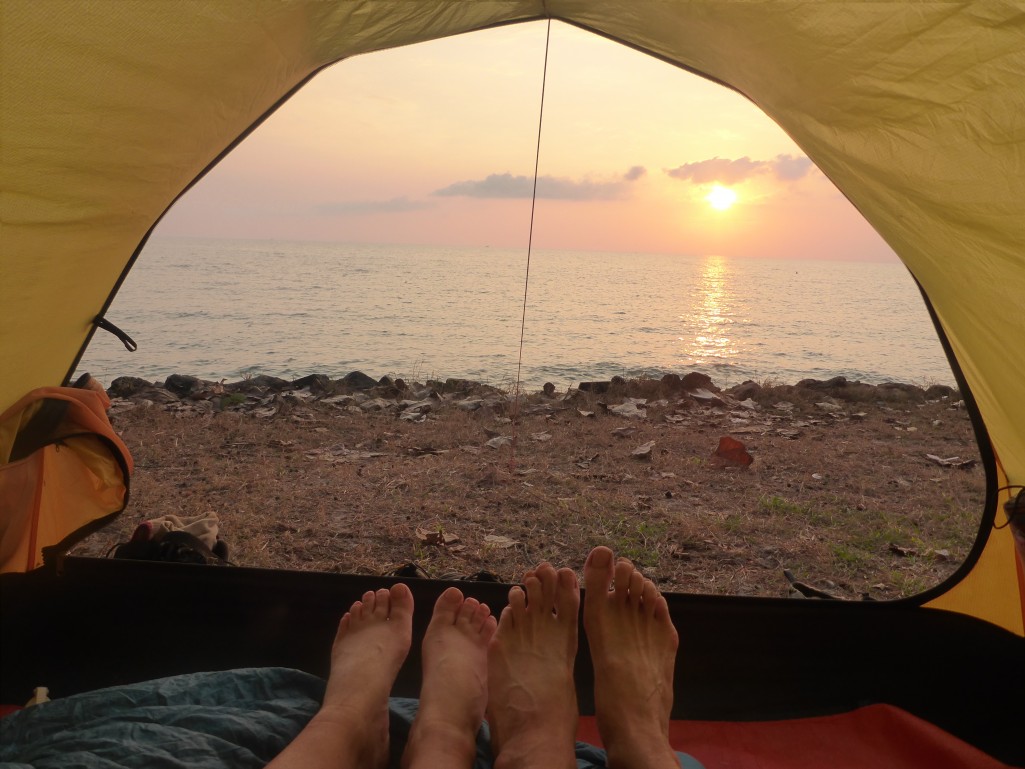
At the Cambodian border the next day the smiling guard suggests we pay for our visa in Thai baht despite all prices being quoted in dollars. We decline given his price works out to be $10 more expensive and hand over good old USDs. I wonder how often this scam works though?

Thailand had been a very easy country to ride through and a useful dose of developed infrastructure compared to the previous countries. As we bump over the bridge into Koh Kong City things look to be more of the rough and ready that we have become used to. We’re into the Cardomon mountains and the heat of the surrounding jungle makes the climbing a sweaty affair. The rivers that weave through the hills provide useful cooling off and washing facilities so we sleep in a hut by one on the first night. Yet again a temple provides refuge on the second night. Shelter and pot noodles are provided in return for some English lessons with a class of young students. Unfortunately we’d sent our ‘Teacher’ shirts home though.
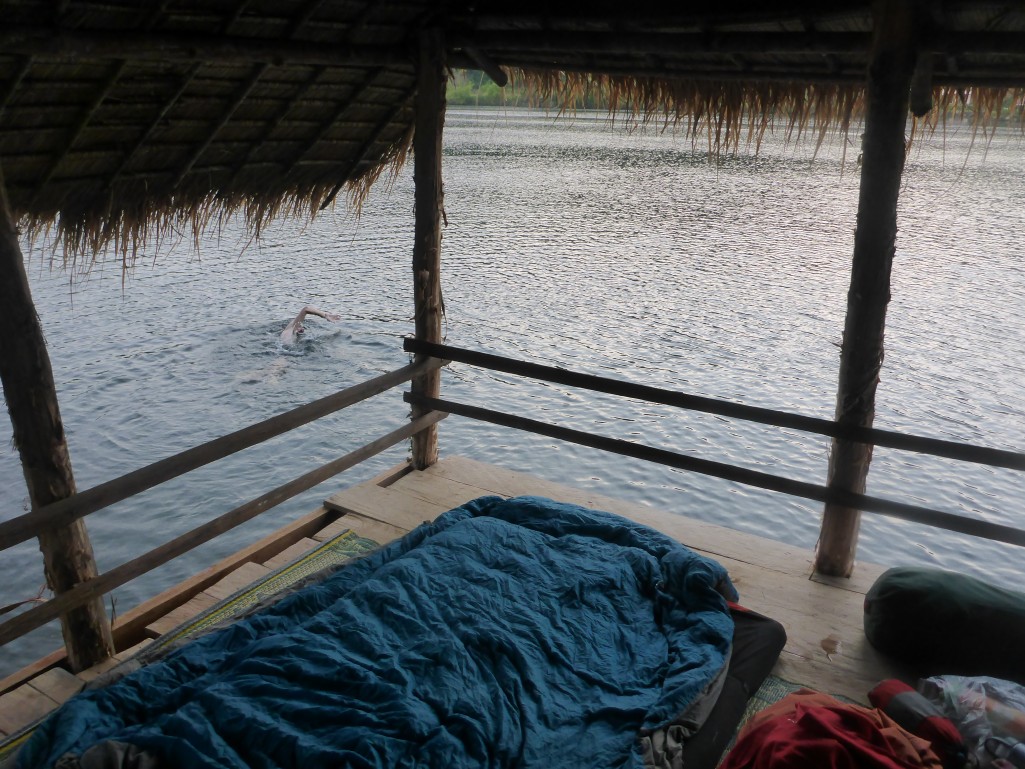
We reach the most southerly point of the trip so far at the turning to Sinoukville, 11 degrees North. From here we turn north and won’t be going any further south for a few more months. The temperature has been climbing to 37 degrees during the day so we hope that things might cool off again from here.
The extensive Thai menus are fading from memory as we return to basic meals of rice and chunks of meat on the bone. However the coffee steps up a level or two and is served over ice unless we request for it to be hot. Asking for milk results in a large dollop of condensed milk in the bottom of the cup and a taste sensation.

We’re on the main highway towards Phnom Penh now and have huge trucks and a dusty hard shoulder as constant companions. The former forcing us onto the latter with a blast of the horn. The towns we pass through are lined with a ramshackle collection of stalls with piles of rubbish grazed by cows, reminiscent of Nepal and India.
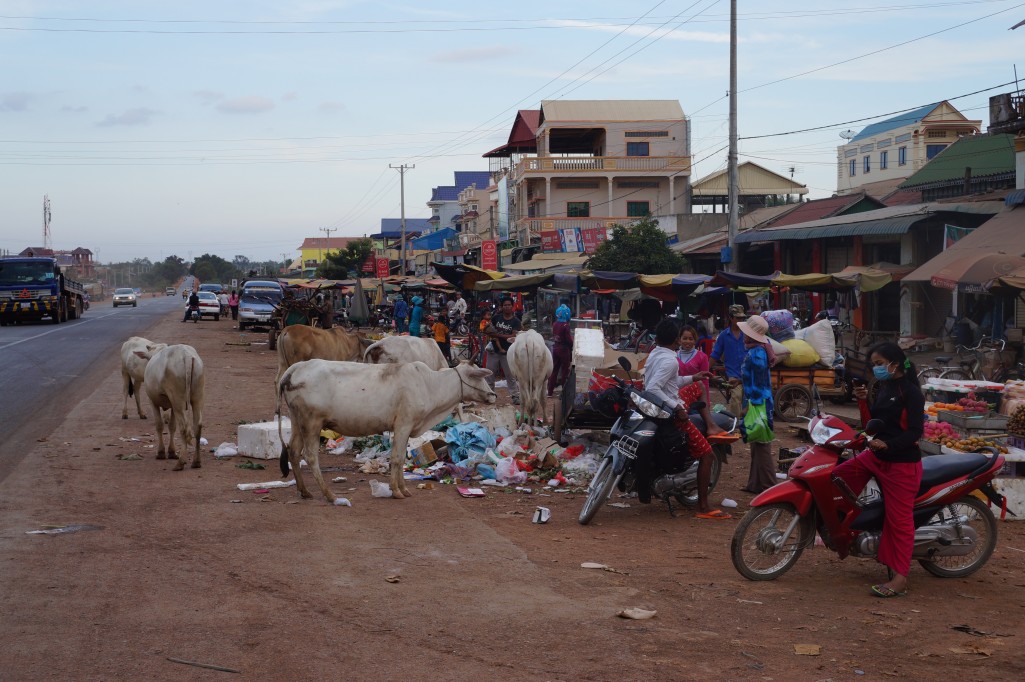
The timing of our arrival in Phnom Penh is perfect. It’s a Sunday afternoon and we make our way to the train station where a group of people in running gear has already begun to assemble. It’s time for the Phnom Penh Hash House Harriers. The ‘Hash Bus’ takes us out of town for a lovely run around some reservoirs and villages before the usual social activities. It’s always interesting to see how diverse the expat community can be and amongst the group are textiles experts for Ralph Lauren, ecologists about to move to an elephant sanctuary, some water engineers who have been working on the Mekong and a Frenchman who once drove from Paris to Afghanistan.

Cambodia has a difficult history and I can still remember the news stories from when Pol Pot died. The pictures of the mass graves as a result of the brutal killings during the days of the Khmer Rouges were shocking but I’m not sure I fully understood the extent of what actually happened.
Near Pnom Penh are ‘The Killing Fields’ where we plug into an audio guide and listen to the harrowing details as we wander around a place where some truly barbaric actions took place. One of the quotes that strikes me most is “..that it is better to kill someone who is innocent by mistake than to not kill someone who is guilty by mistake…”. During this dark period in the late 1970’s 1/4 of the population was wiped out, 2 million people.
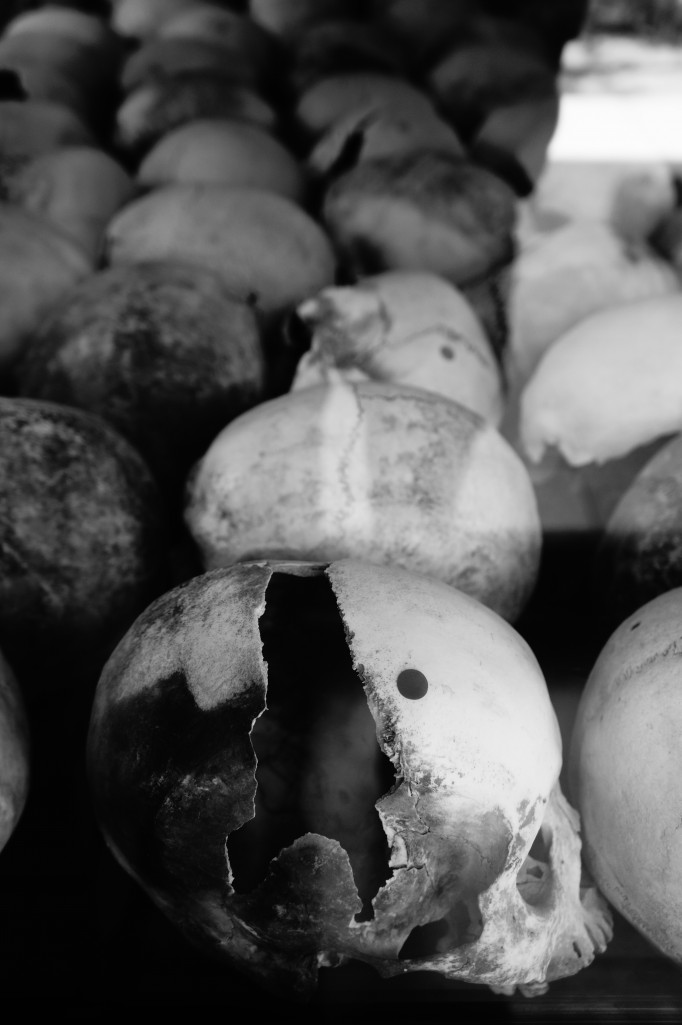
This is now a place of quiet contemplation as visitors walk slowly round the meadows and soft hillocks where an unknown number of people were buried. Although most of the remains have been exhumed, when it rains bones and clothing are still being revealed and have to be carefully collected. It’s impossible not to catch a lump in your throat as the voices on the audio guide give first hand accounts of their experiences. We leave feeling shell-shocked and emotionally drained much as we had when we visited the Museum of Occupation in Riga. As we’ve seen, 99.9999% of the world is full of immense kindness but the remaining 0.0001% seem to be able to do so much damage.
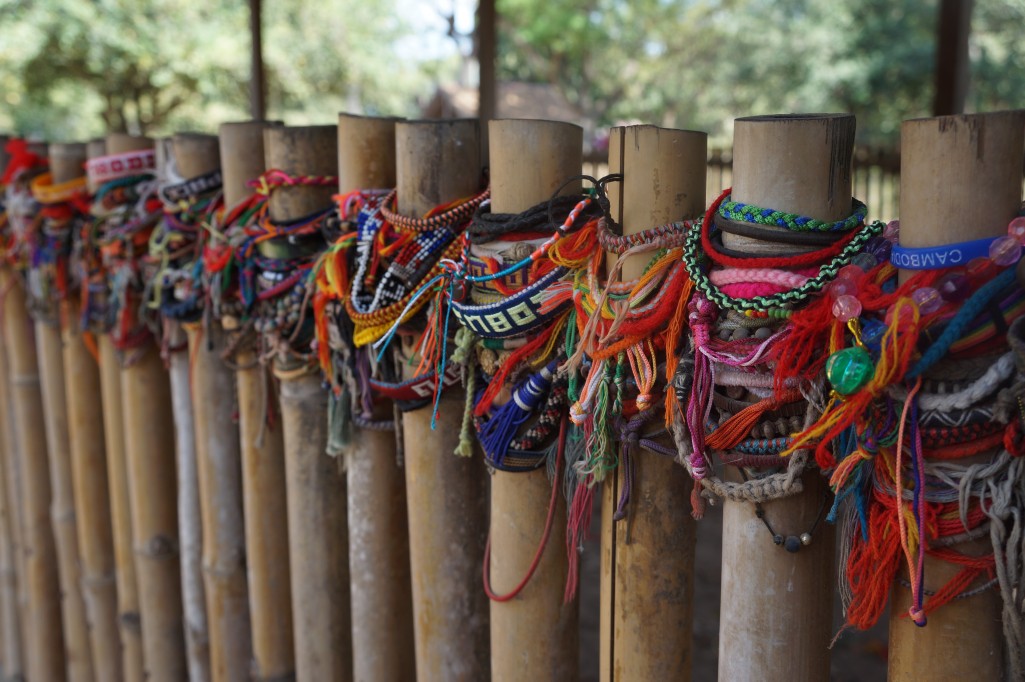
A more heart warming story comes from the charity Daughters of Cambodia who my uncle had told me to look out for as he knows the founder. Their mission is to take girls out of the sex industry and provide them with the skills to take on new careers. Their cafe, Sugar and Spice, sells great food and beautiful products all managed and made by girls from the programme. It’s great to see that it’s been such a success and represents a more promising future for the country.
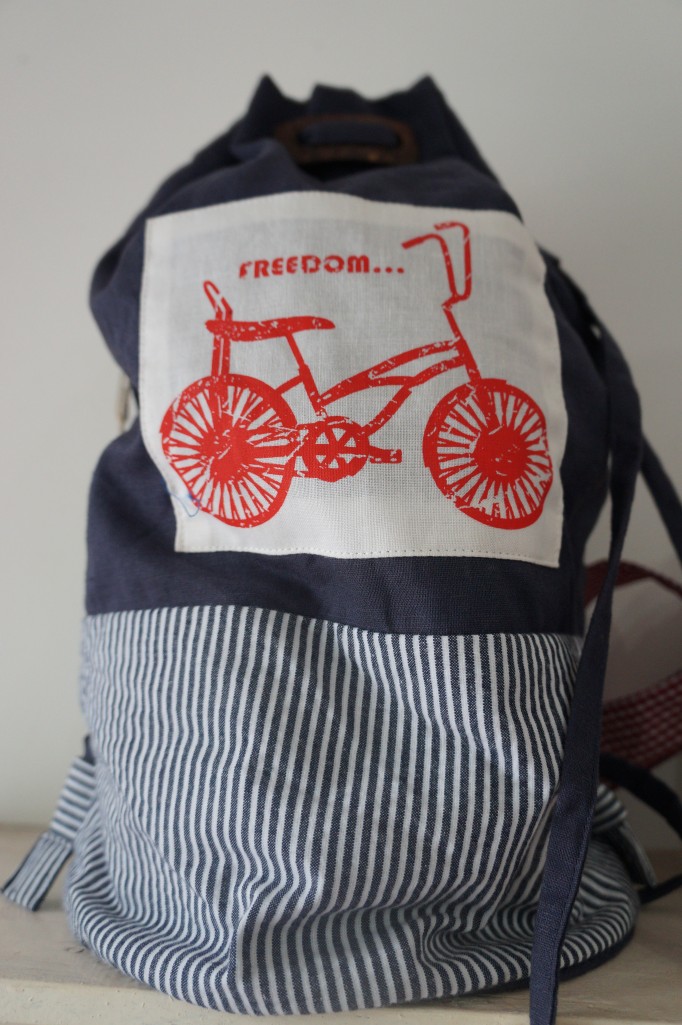
This capital is vastly different from Bangkok. The decrepit French colonial architecture gives it a 19th century feel. The traffic makes its own rules based on force of numbers so we have to gang up with a cluster of scooters to be able to pull out from any junction. The alloy wheels and polished exhausts of the tuktuks in Thailand have been replaced by battered scooters towing four seater wooden trailers. It has a charm and character that is appealing though and perhaps this is how Bangkok once looked before modernisation took hold.
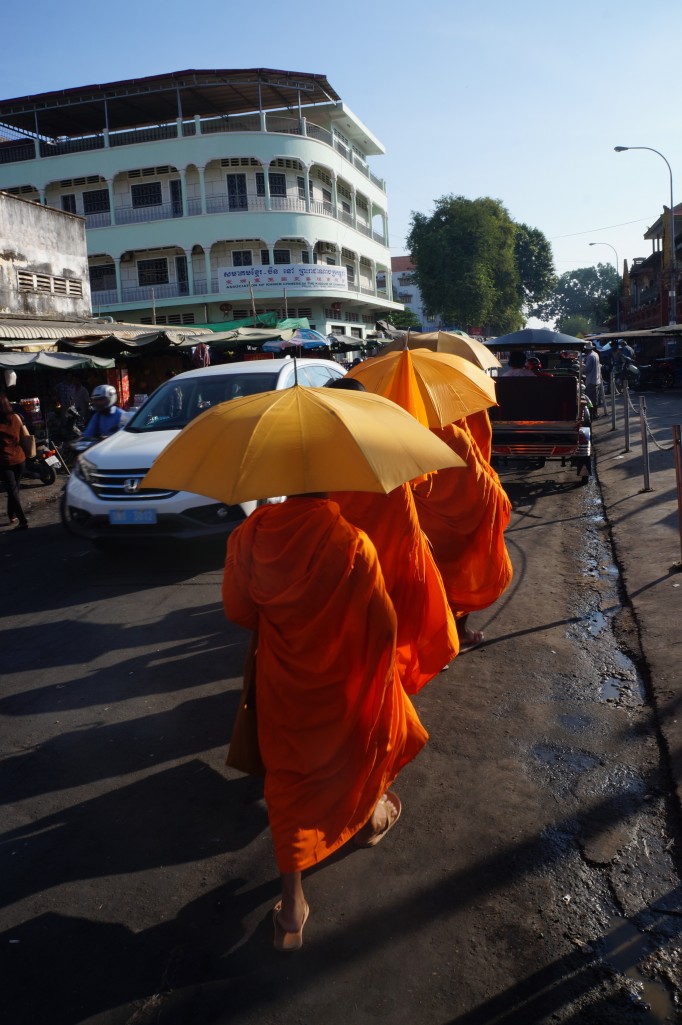
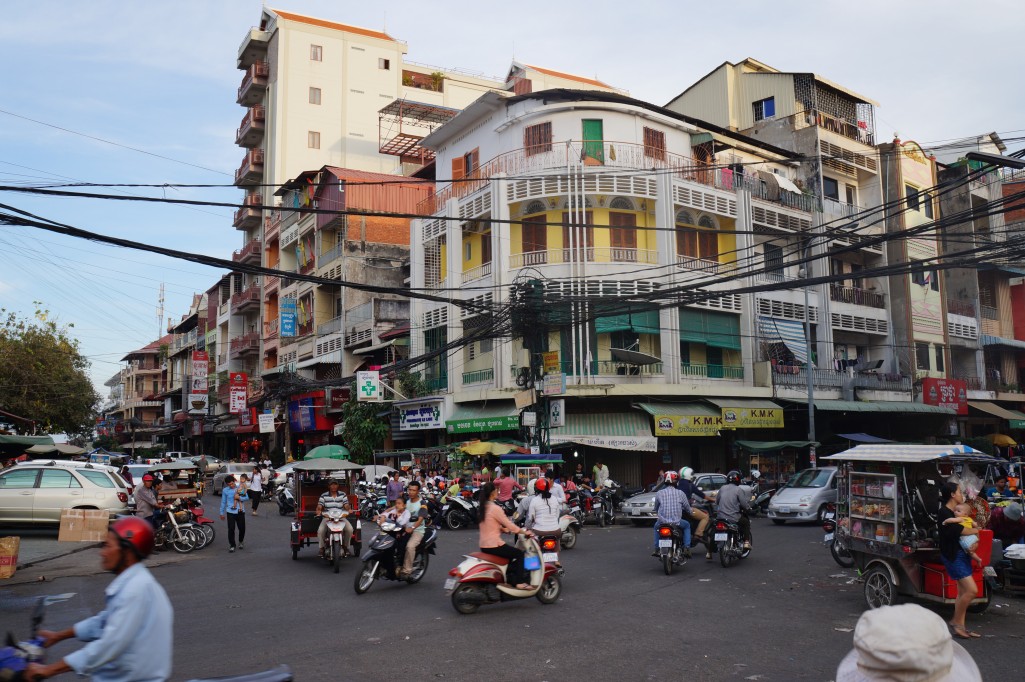
Although Cambodia is lacking in the food department compared to its neighbour it does hold the trump card when it comes to historical sites in South East Asia. Angkor Wat is so important that it’s shown on the national flag and one of the most popular beers is named after it. After a breakfast of eggs and bacon (imported from Thailand) we set off in the direction of Siem Reap to have a look at this most famous of temple complexes. North being our chosen direction now.
